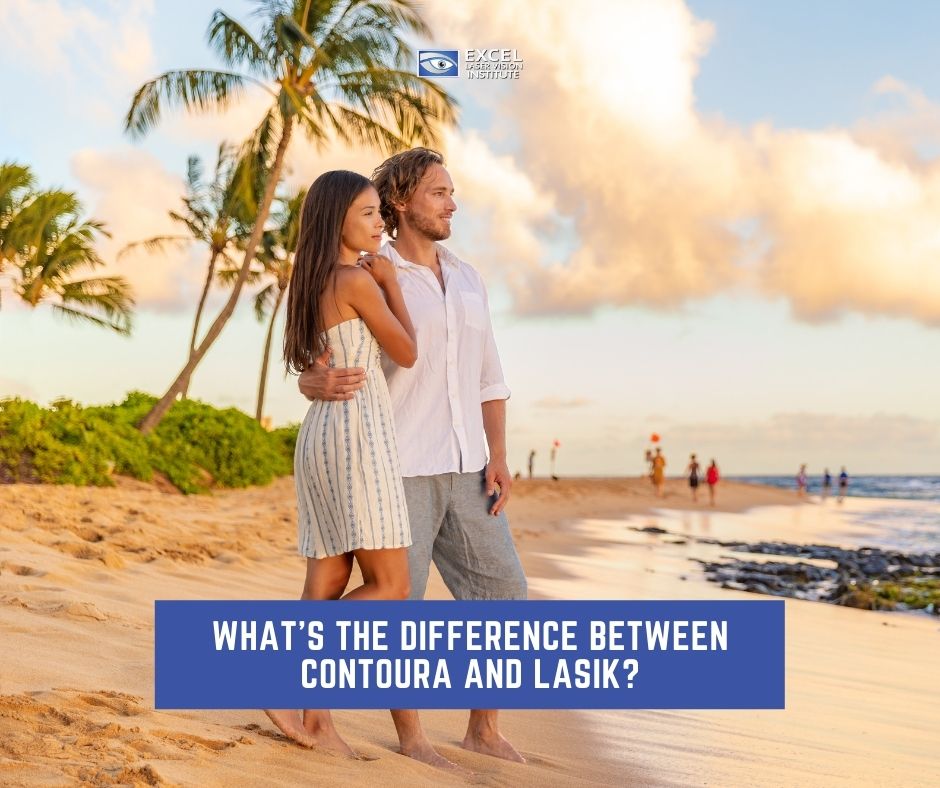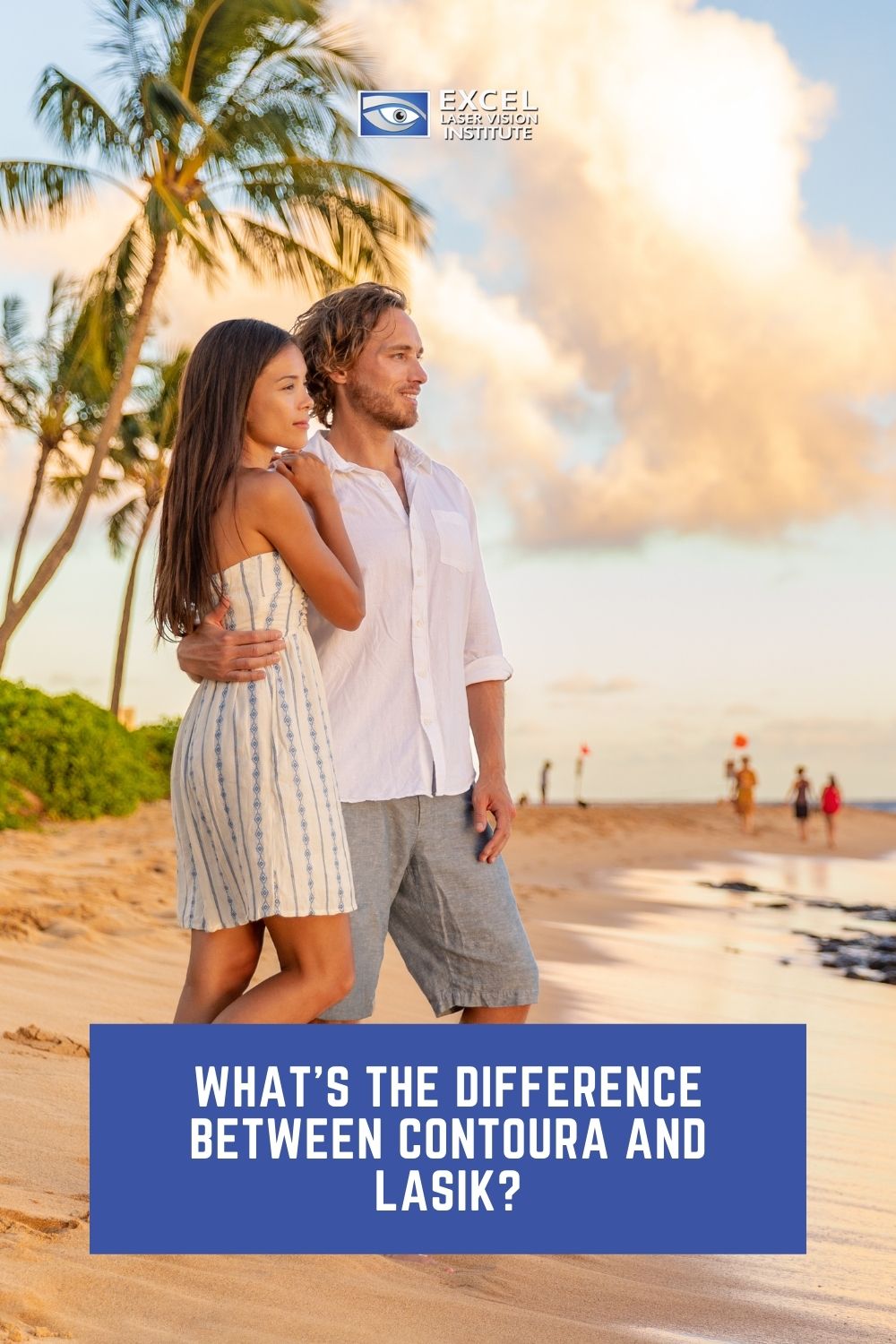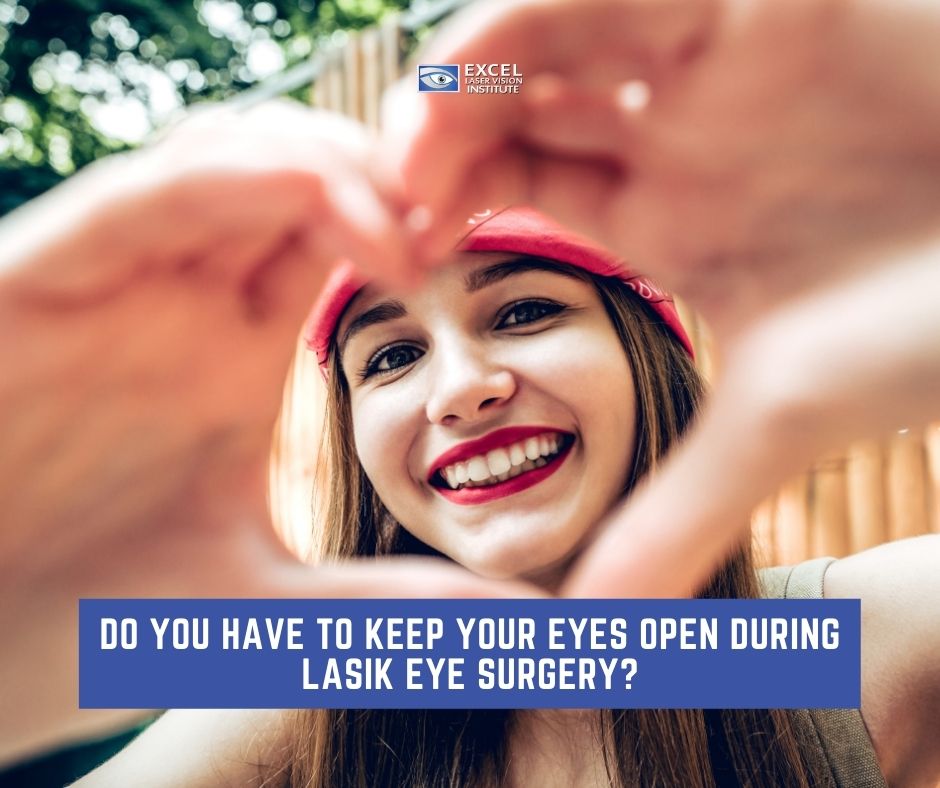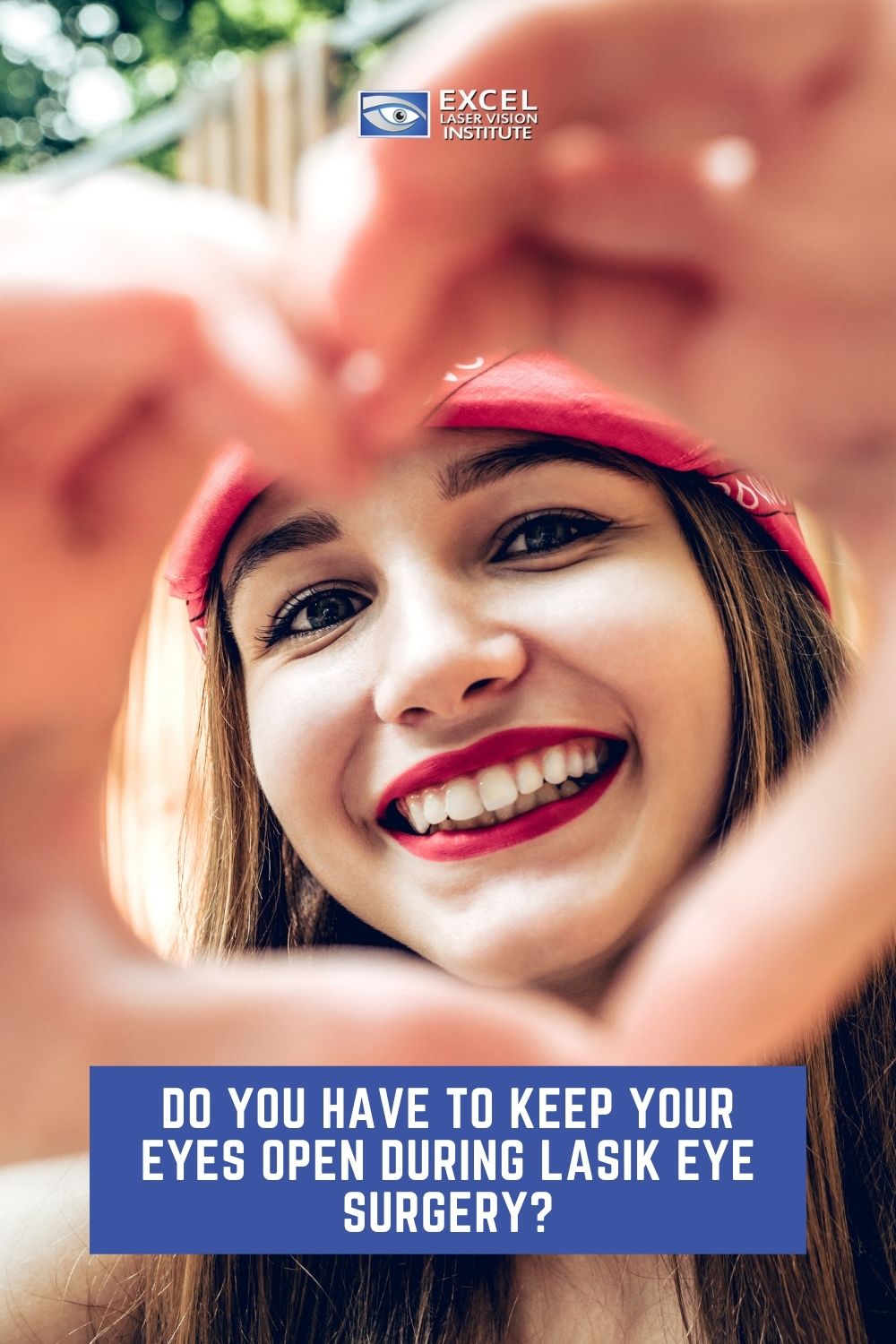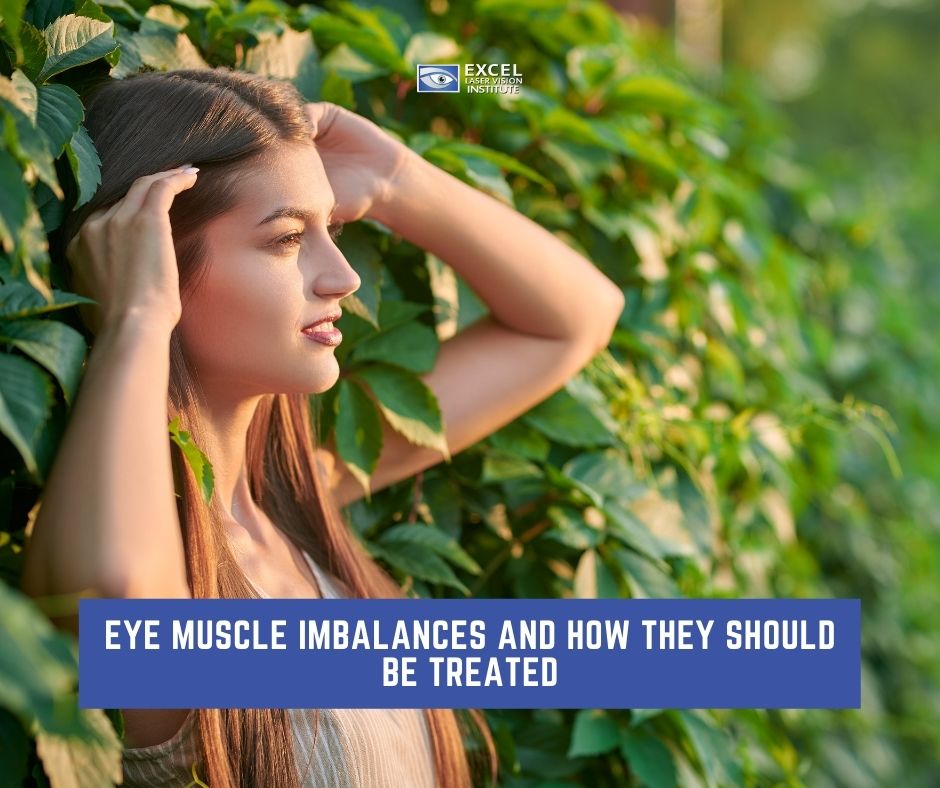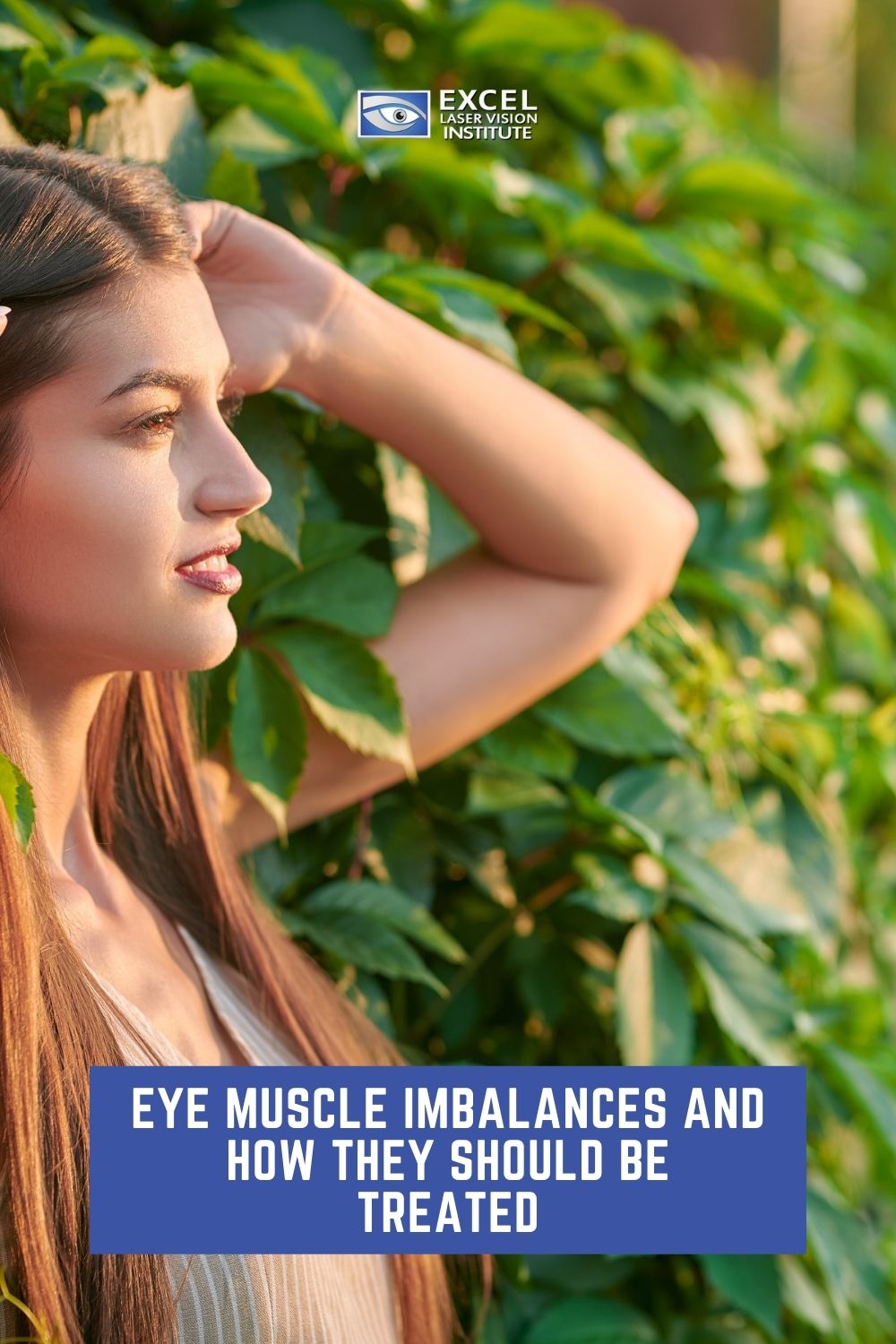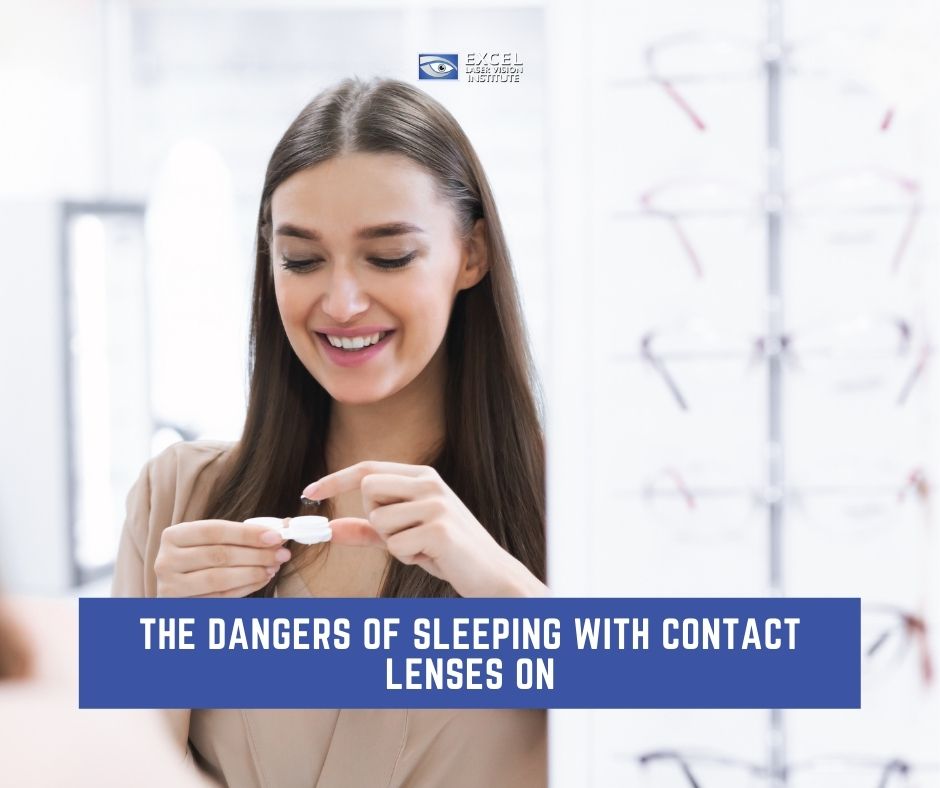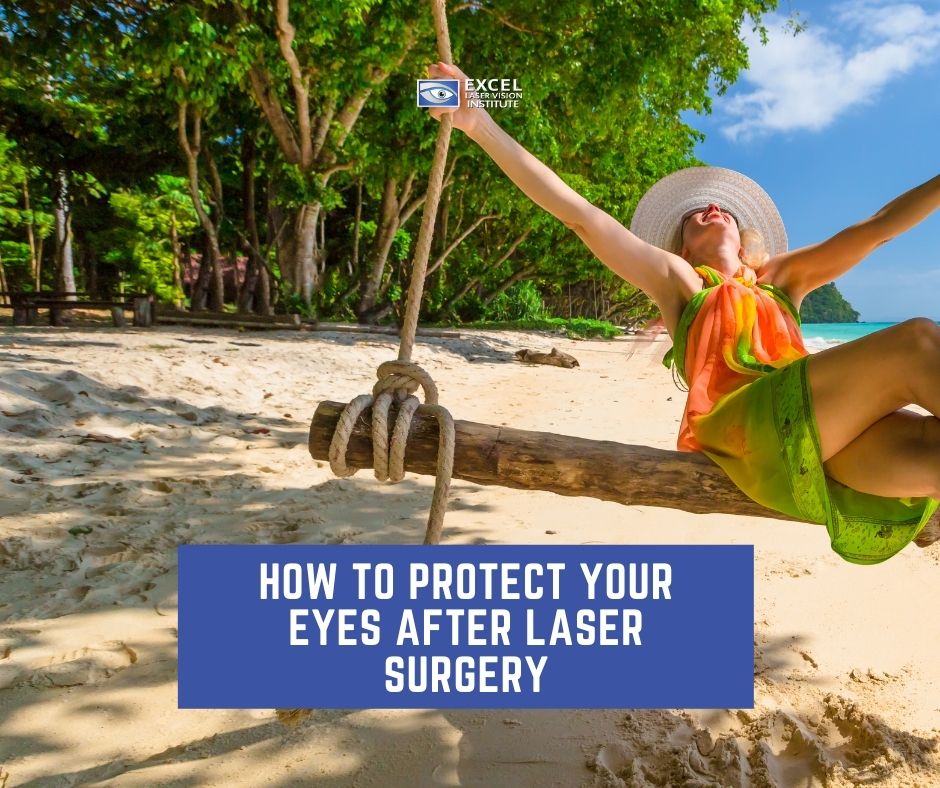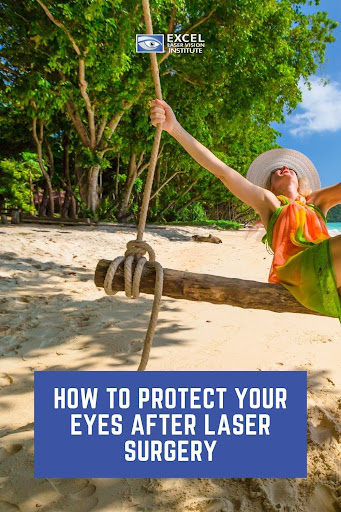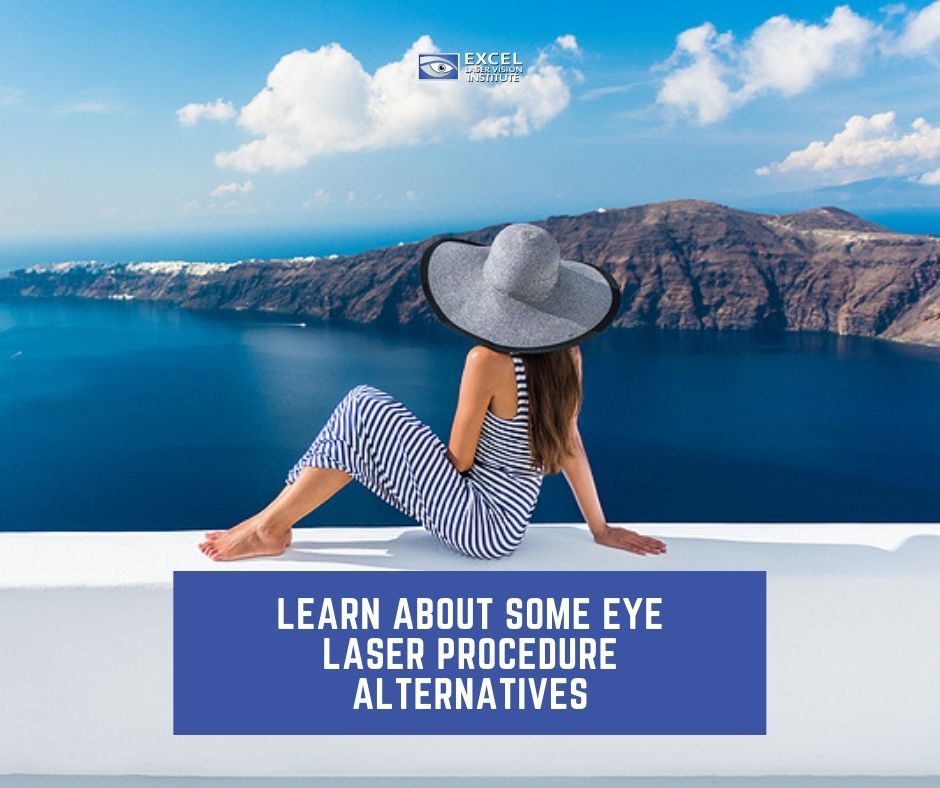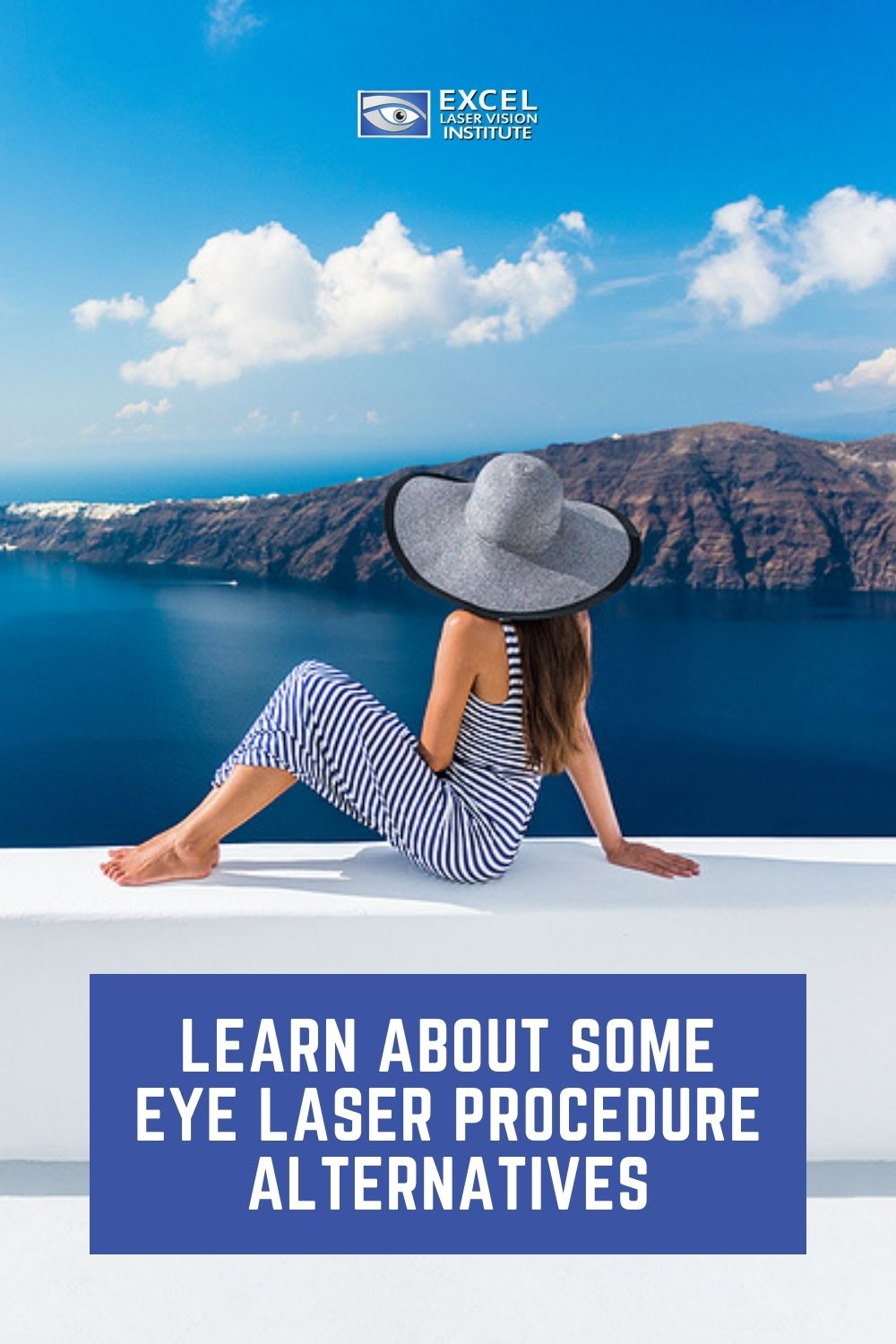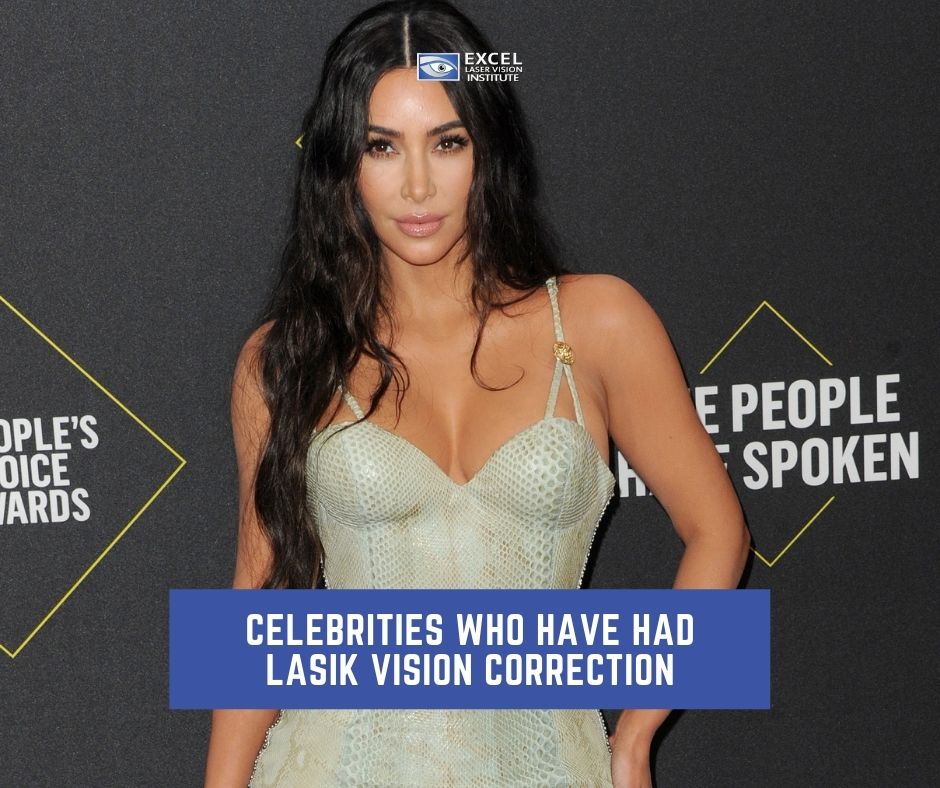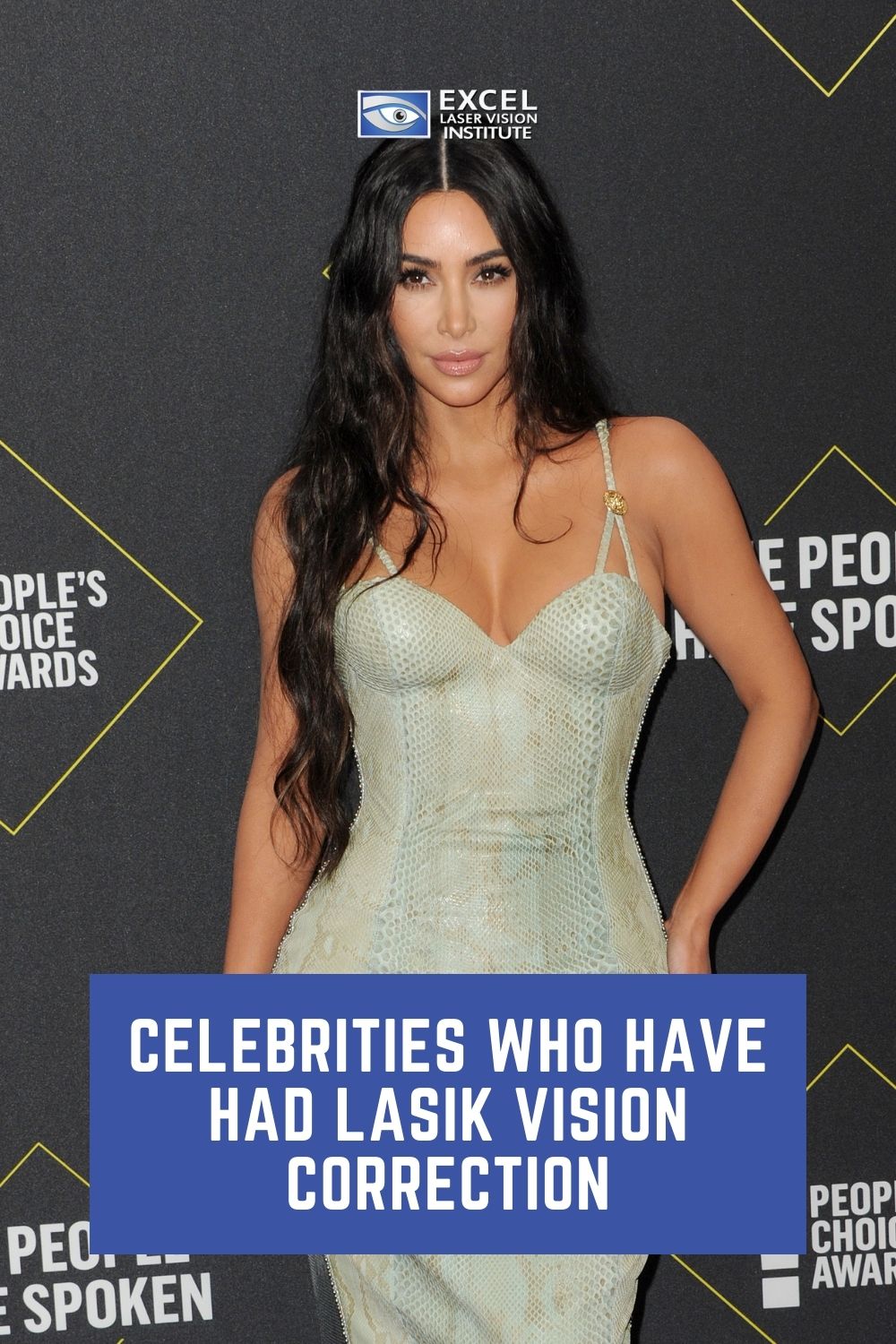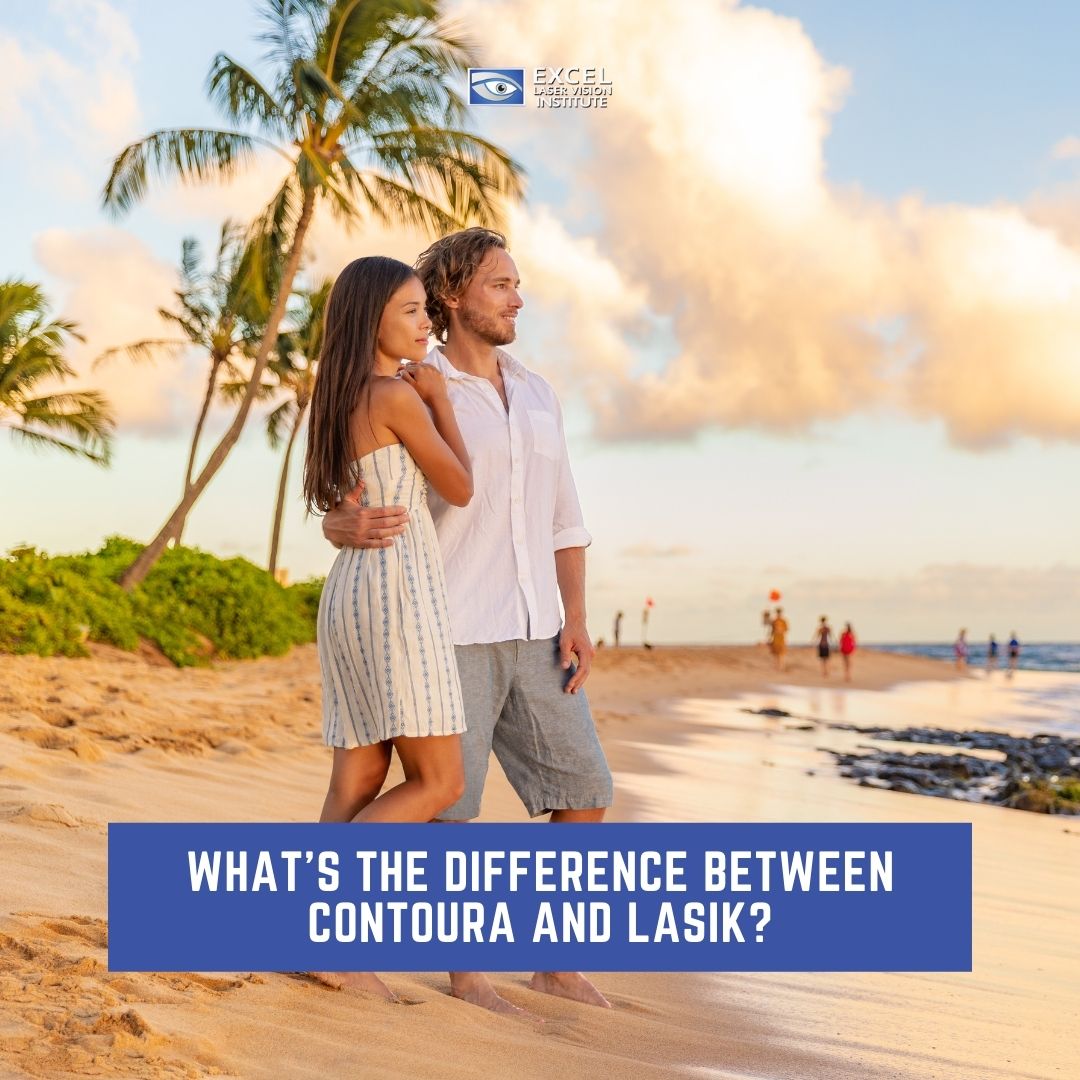
What’s The Difference Between Contoura and LASIK?
The eye doctors explain that LASIK is a procedure that utilizes a laser to alter the shape of the cornea to make adjustments to certain eye conditions such as myopia, hyperopia, or astigmatism. Over the last thirty years, new technology advancements have mainly concentrated on improved methods to measure the corneal curvature or topography and then guide the laser to correct these topographical discrepancies.
At Excel Laser Vision Institute, a LASIK eye surgery clinic in Orange County, Contoura Topography-guided LASIK is a new technology that measures the overall curvature of the cornea to measure slight corneal topographical imperfections.
To give you a broader view of Contoura technology, it is good to understand the history of LASIK.
LASIK In The Early Years
In the 1990s, a few European eye doctors decided to improve photorefractive keratectomy (PRK) to enhance refractive surgery. This enhancement, which was known as “flap and zap,” was the inception of LASIK. Its prototype (PRK) was approved in 1995 by the FDA. During PRK, the front surface of the eye is directly modified by the laser. Because PRK treated the external surface of the eye, it had a healing time of several weeks or months, and patients experienced some discomfort.
The FDA approved LASIK in 1999, and it dazzled everyone for its ability to offer vision correction with minor discomfort and a shorter recovery time. From the time it was introduced in 1999, the improvements began in better measures of the cornea and more precise ways to correct the corneal curvature. The first massive update was Wavefront analysis which advanced accuracy through corneal mapping. By 2003, Wavefront-guided custom LASIK became extensively available globally, and LASIK was the most commonly performed elective procedure. Since Wavefront came on the scene, LASIK has gone on to progress and become even more accurate.
In 2015, the FDA approved the most recent and the greatest when it comes to customized LASIK Contoura Vision topography-guided LASIK.
What Is Contoura Vision?
Essentially, Contoura Vision is an exceptionally advanced, accurate, and individualized LASIK treatment. The advanced technology provides surgeons with an exact, detailed mapping of the cornea, which lets eye surgeons offer customized care for each patient’s eyes. The cornea has over 22,000 unique elevation points, which are analyzed and sent to the surgical planning computer that directs the laser beam to correct the minute curvature variations at each end.
The advanced, personalized nature of Contoura Vision provides patients with a vision that is undeniably anything better than they have ever experienced with eyeglasses or contact lenses. Contrary to traditional LASIK that focuses on refractive errors by repairing the overall shape of the cornea, topography-guided LASIK also concentrates on abnormalities affecting the surface texture of the cornea. Also, some results indicate improvement in contrast sensitivity with topography-guided LASIK.
How Does Contoura Work?
The LASIK eye surgeon will use a topographer and the WaveLight® EX500 Excimer Laser to carry out this procedure. Topography-guided LASIK helps to change the shape of the patient’s cornea, significantly enhancing vision. Since the Contoura procedure is specially customized to each patient’s cornea, the possibilities of experiencing glare, light sensitivity, and halos after the procedure are decreased.
Topography-guided LASIK, better known as Contoura, is a customized treatment that uses an assortment of very detailed images on each patient’s eyes to determine a patient’s specific vision correction requirements. When the patient’s eye is imaged and analyzed using the over 22,000 unique elevation points on the cornea, the data is sent to a surgical planning computer to create their custom profile to optimize the patient’s vision.
How Long Is A Contoura Procedure?
Topography-guided LASIK surgery and Contoura vision surgery are the same. The procedure’s process is identical to LASIK surgery. However, the technology involved is different from conventional LASIK surgery. A comprehensive eye check-up of the patient is carried out to eliminate the existence of any diseases or infections. The laser eye surgery is done under the effect of local anesthesia.
A Contoura procedure makes around 22,000 points on the cornea through topography. Every point is checked for abnormality and is corrected through LASER. The machine that is involved in the Contoura vision includes WaveLight EX500 Excimer Laser Systems and WaveLight TopolyzerVario Diagnostic Device. Excel Laser Vision Institute has the latest technlogy of WaveLight EX500 Excimer Laser.
To get the best result after LASIK eye surgery, you must follow your LASIK surgeon’s advice on eye care. They will prescribe eye drops such as anti-inflammatory and antibiotics to prevent inflammation and infection.
Contoura Recovery
LASIK patients will see very noticeable visual improvements right after their Contoura Vision LASIK procedure. However, recovery time is different for everyone. For instance, if you are a patient with a higher prescription, your recovery might be a little slower than someone with a lower prescription. Besides resting with protective eye shields in a postoperative room for around an hour, your laser eye surgeon will recommend the following:
Designate someone to drive you home after surgery and help you pick up any medications that you may have been prescribed
Please keep your eyes clean and try not to rub them
Get comfortable rest at home for at least an hour wearing your protective eye shields
Follow any additional postoperative instructions your eye surgeon may give you
It is not unusual for the patient to experience mild to moderate discomfort during the first couple of days after surgery as their eyes heal. Some patients may experience minor issues such as red or watery eyes for the first few days after the procedure, but others can get back to work the next day. Doctor Moosa, your LASIK surgeon at Excel Laser Vision Institute in Orange County, will prescribe medications to help you with any discomfort. He schedules a follow-up appointment the next day to test your vision to make sure your eyes are healing correctly.
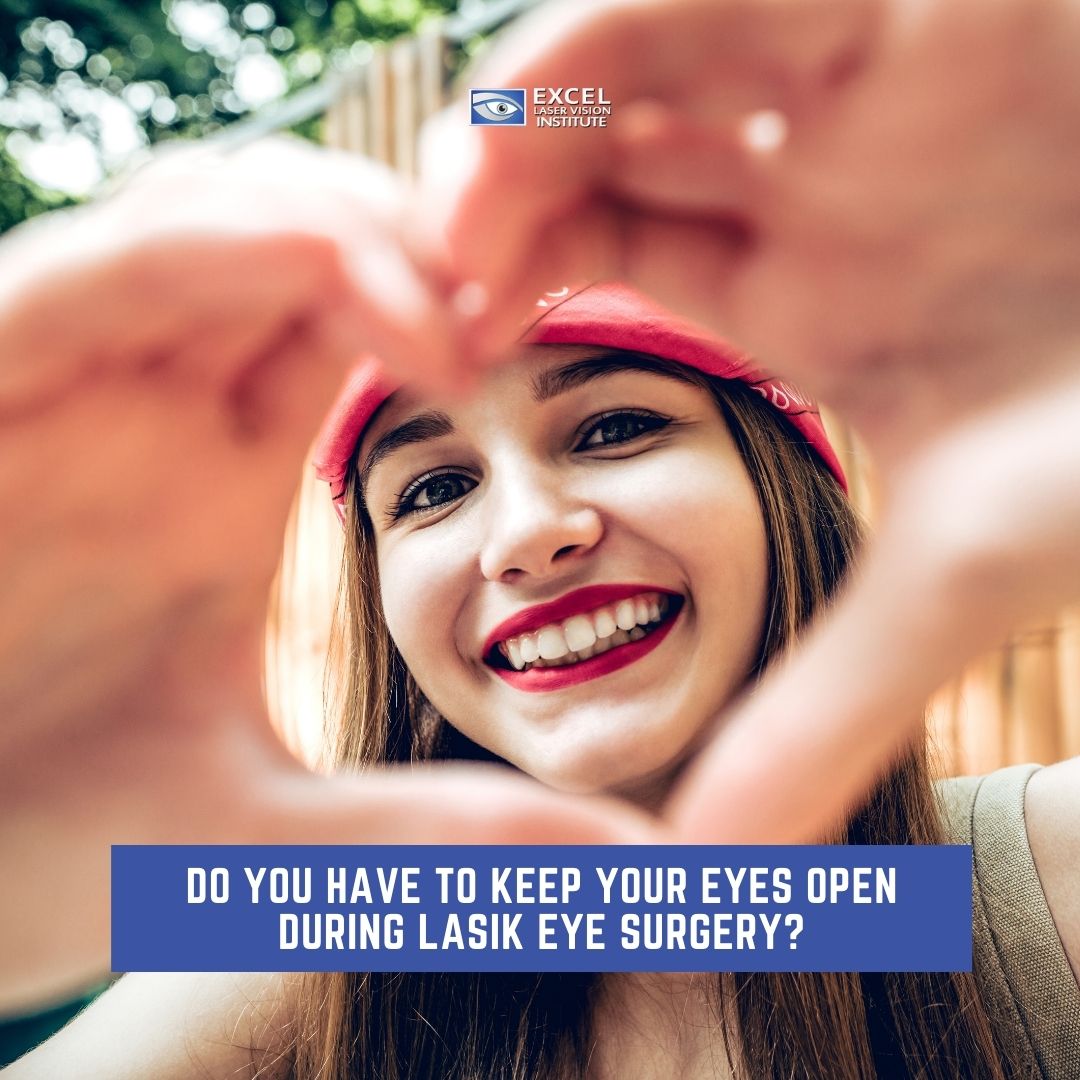
Do You Have To Keep Your Eyes Open During LASIK Eye Surgery?
Just the name laser eye surgery has some people shaking in their boots, but they don’t have to be scared, especially if they are going to get LASIK at Excel Laser Vision Institute in Orange County, where the most experienced eye doctor, Doctor Moosa, handles these procedures.
Perhaps the biggest fear many people have about LASIK is keeping your eyes open throughout the entire procedure. Heavens to Betsy, it does sound frightening, but the laser eye surgery doctors can guarantee you won’t feel a thing.
Patient’s Fears
Recently surveys revealed that this was the number one reason why people refused treatment, even before having an initial consultation. Surgical procedures require anesthetic most of the time, and LASIK is no exception even with just a few numbing eye drops. That is all that is administered to perform laser eye surgery while patients are completely conscious.
Although the LASIK surgeon in Orange County can understand that being awake during a surgical procedure doesn’t sound like a blast to anyone, LASIK is a far cry from your standard surgical procedure. Beginning with the matter that the procedure only takes a few minutes to perform.
However, what really changes the game up is that laser eye surgery, when done in expert hands by a LASIK expert in Orange County such as Doctor Moosa, is painless and, what is more, being conscious during the procedure does not in any way, shape or form put you at harm’s way, even if you try your utmost to.
What Happens If I Blink During LASIK Surgery?
You are not the only person who has this concern. However, you can stay rest assured that blinking and moving during LASIK surgery is usually not an issue. Numbing drops are administered to the patient’s eyes before surgery to make the LASIK procedure comfortable and decrease a patient’s natural urge to blink. Plus, a small device holds the eyelids open during the procedure so the patient can’t accidentally blink and your eyelids open during the procedure so the patient doesn’t unintentionally blink and their eyelids can’t interfere with any stage of the surgery.
Is It A Problem If I Move During Laser Eye Surgery?
Moving your head and body is also a serious concern. The patient usually lies down on a flat, comfortable, cushioned surface (about 20 minutes for both eyes). Depending on the type of laser your eye surgeon uses, many platforms have a contoured headrest that snugly supports the head during the procedure. Your LASIK surgeon may carefully hold your head in position to help you stay steady during specific stages of the procedure.
Nearly all lasers used for LASIK surgery performed in the United States are equipped with an advanced feature called an “eye tracker” that immediately keeps track of the position of the patient’s eye and modifies the laser treatment to compensate for any small, involuntary movements your eyes may make during surgery. This technology is crucial for custom LASIK and to carry out the most precise laser treatment of the patient’s eyes.
What To Do After LASIK Surgery?
When you have completed your laser eye surgery, you must follow your doctor’s guidance on the simple LASIK recovery steps so that your eyes can perform outstandingly well.
Have a friend drive you home after you had your successful eye surgery, and don’t forget to wear your sunglasses. Make sure to rest your eyes and keep them closed so that they remain comfortable.
You want to aim to keep your eyes closed for 2 to 4 hours as part of your critical LASIK recovery process. For this reason, taking a nap and wearing your clear plastic shields will help with the recovery process.
Don’t be alarmed if you feel mild sensitivity for a few hours, but there should be the slightest discomfort. When the two to four hours are up, remove the plastic shields and, as instructed by your surgeon, start using your prescribed eye drops for healing and to keep your eyes comfortable and lubricated.
Try not to rub, squeeze or touch your eyes after LASIK surgery because the surface of your eyes are still sensitive. Wear your plastic shields when sleeping and if your eyes still have issues tolerating light, wear sunglasses. If your eyes get dry or irritated, use preservative-free artificial tears to help keep your eyes comfortable.
Most LASIK surgeons will tell you to rest for the first 24 hours following your laser eye surgery. So, refrain from reading, strenuous activity, computer work, and television during this period.
When To Delay Your LASIK Procedure
If you constantly suffer from dry eyes, it may stop you from getting LASIK treatment. To find out if LASIK is the correct route for you, talk to your eye doctor at a reputable LASIK clinic. Your eye doctor will guide you on the most appropriate ways to receive LASIK with your dry eye condition.
Ultimately, scheduling your LASIK procedure may not be a huge deal; however, getting it done by the right doctor is very important. Although the technology used in LASIK is phenomenal, it has to be carried out by a qualified and experienced ophthalmologist to achieve the best results.
If you want more details about LASIK eye surgery, contact Excel Laser Vision Institute at (888) 957-3255. Our team of staff is highly trained and experienced. Dr. Moosa, a well-known LASIK surgeon in Orange County, studied at Harvard University and has experience working with various prescription levels. Dr. Moosa has helped many professionals with their eye issues, from athletes to models to military personnel. Visit our website to learn more: https://www.exceleye.com/.
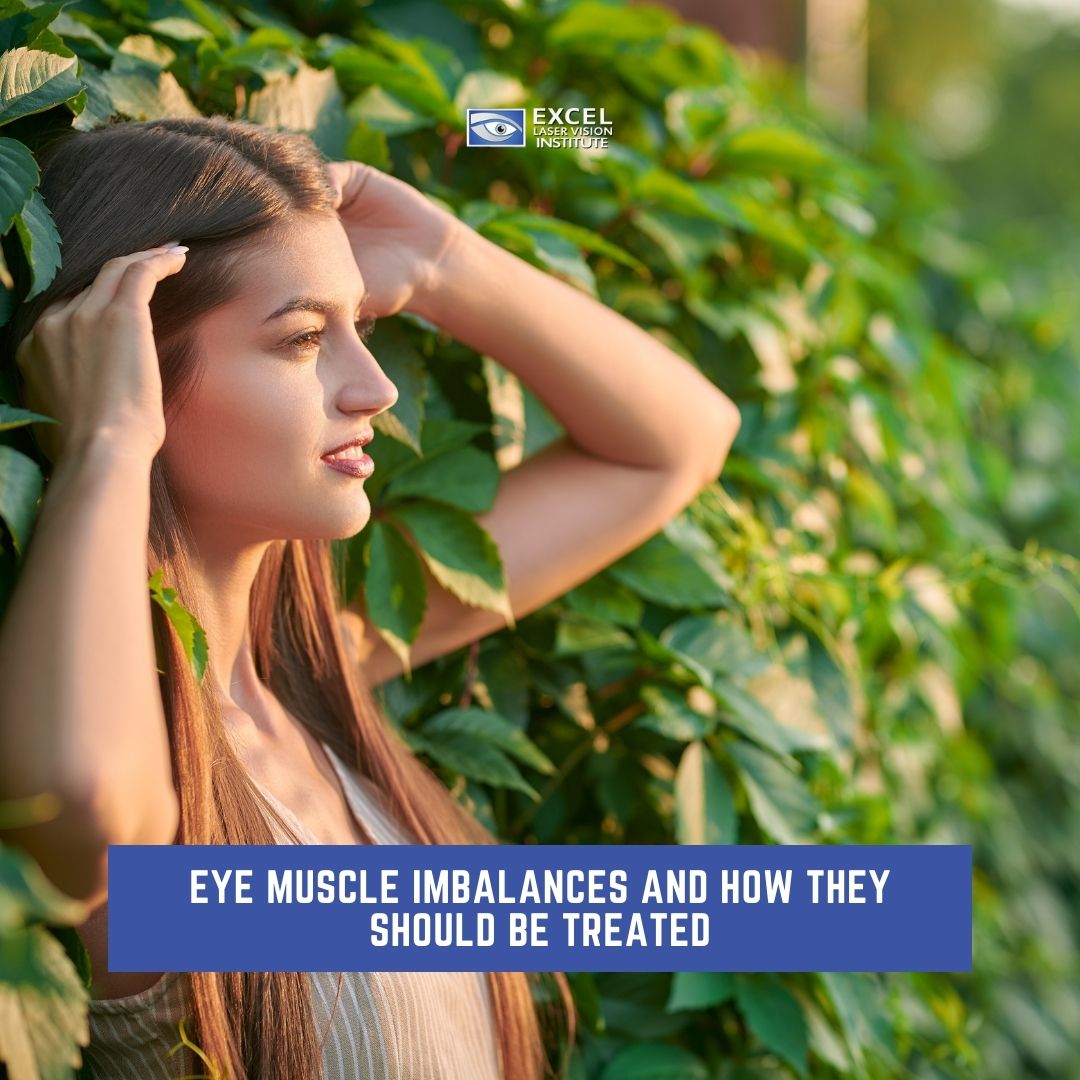
Eye Muscle Imbalances And How They Should Be Treated
Doctor Moosa, a LASIK specialist in Los Angeles, educates us on the fact that eye muscle imbalance is a highly complex disorder. A common form of eye imbalance is strabismus, a visual issue where the eyes are lined up correctly and point in various directions. One eye could look dead-on, while the other eye turns inward, outward, upward, or downward. The eye turn may be constant, or it could reappear. The eye that is straight and which is misaligned may change or alter.
Normally children experience strabismus. As a matter of fact, a LASIK eye surgery expert informs us that 4 percent of all children in the United States have strabismus. However, strabismus is not only prevalent in children because adults are also susceptible to it. Plus, it can be genetic; yet, many people with strabismus do not have any relatives with the issue.
What Is Strabismus?
It is a shortcoming in eye muscles that leads to horizontal or vertical misalignment. Typically, six muscles move the eye, and the different types of strabismus go hand in hand with the various muscles involved.
The body moves these six muscles around to avoid the eyes from simultaneously concentrating on one object, so two disputing images are transmitted to the brain at the same time. Both eyes look at the same object and send only one image to the brain in normal circumstances.
A child with strabismus and maybe needing corrective eye surgery is usually taught to ignore or suppress the image recognized by the misaligned eye. The normal eye becomes predominant, while the misaligned eye evolves less vision due to absence of use. This vision reduction in one eye is amblyopia, and about 50% of children with strabismus develop amblyopia.
What Is Lazy Eye?
The LASIK eye doctors in Los Angeles inform us that the medical term for ‘lazy eye’ is amblyopia, a condition in which the eyes are misaligned or don’t work well together.
The causes of amblyopia can vary, and most of all, each cause needs different treatment:
Refractive amblyopia: A condition that affects one eye’s vision that makes the prescription a lot stronger than the other. Eventually, the dominant eye will carry out more work, resulting in the weaker eye falling out of alignment. Fortunately, refractive vision issues can be straightened out with LASIK or laser vision correction in Los Angeles.
Strabismus amblyopia: Is an imbalance in the muscles that lay out the eyes. One eye seems to falter behind the other, and in the long run, this results in a weakened vision in the eye that’s faltering.
Deprivation amblyopia: Also known as “obstructed amblyopia,” is when one eye’s vision becomes obstructed, usually by cataracts or another condition. Ultimately, the brain begins to support the other eye. This form of lazy eye is most common very early in life and may occur in elderly people because of age-related vision issues.
Can You Correct A Lazy Eye With LASIK?
LASIK is well known for being a laser eye surgery that enhances vision by fixing refractive vision problems. LASIK can remedy a lazy eye, but only when the root of the issue is a discrepancy in the refractive error between both eyes (refractive amblyopia). LASIK surgery can lead to a similar prescription in your eyes, lowering the issues that come with having one eye working like fury than the other.
Although LASIK isn’t a surefire fix for refractive amblyopia, it is a significant determinant in recovering from the condition. LASIK works well together with other amblyopia therapies that help the brain to begin to comprehend the improved vision in your lazy eye.
If amblyopia results from misaligned/crossed eyes or obstructed vision, laser eye surgery is going to do nothing to improve the condition. Also, LASIK can’t be carried out on minors, so it is not ideal when amblyopia affects children.
Can You Even Correct A Lazy Eye?
Although LASIK can help treat refractive amblyopia, it can’t be of any benefit with other types of lazy eye and cannot treat children. Therefore, there are other ways of treating different types of amblyopia. These treatments are applied on their own and, in some situations, with LASIK.
Most of the time, treatments involve making the vision the same in both eyes so that the brain is forced to use the lazy eye. Occasionally, this means improving the lazy eye’s vision with a more powerful glasses’ lens prescription than in the other eye. For some cases, this means blocking the “good” eye with either an eyepatch or eye drops to obstruct vision, coercing the brain to use the lazy eye.
Eye exercises are also an excellent way to manage a lazy eye. These usually involve the patient focusing on small or fixed objects or words for long periods, making the brain work in conjunction with the eyes.
Another factor is dietary habits since the proper vitamins can help with brain activity and eyesight. Remember that all of these treatments should only be done under your doctor’s guidance.
If you want to discover more about how LASIK can help your eyesight and perhaps correct eye muscle imbalances, contact Excel Laser Vision Institute at (888) 957-3255 or visit our website. Our expert team and highly reputable LASIK surgeon, Dr. Moosa, are happy and willing to answer all your questions.
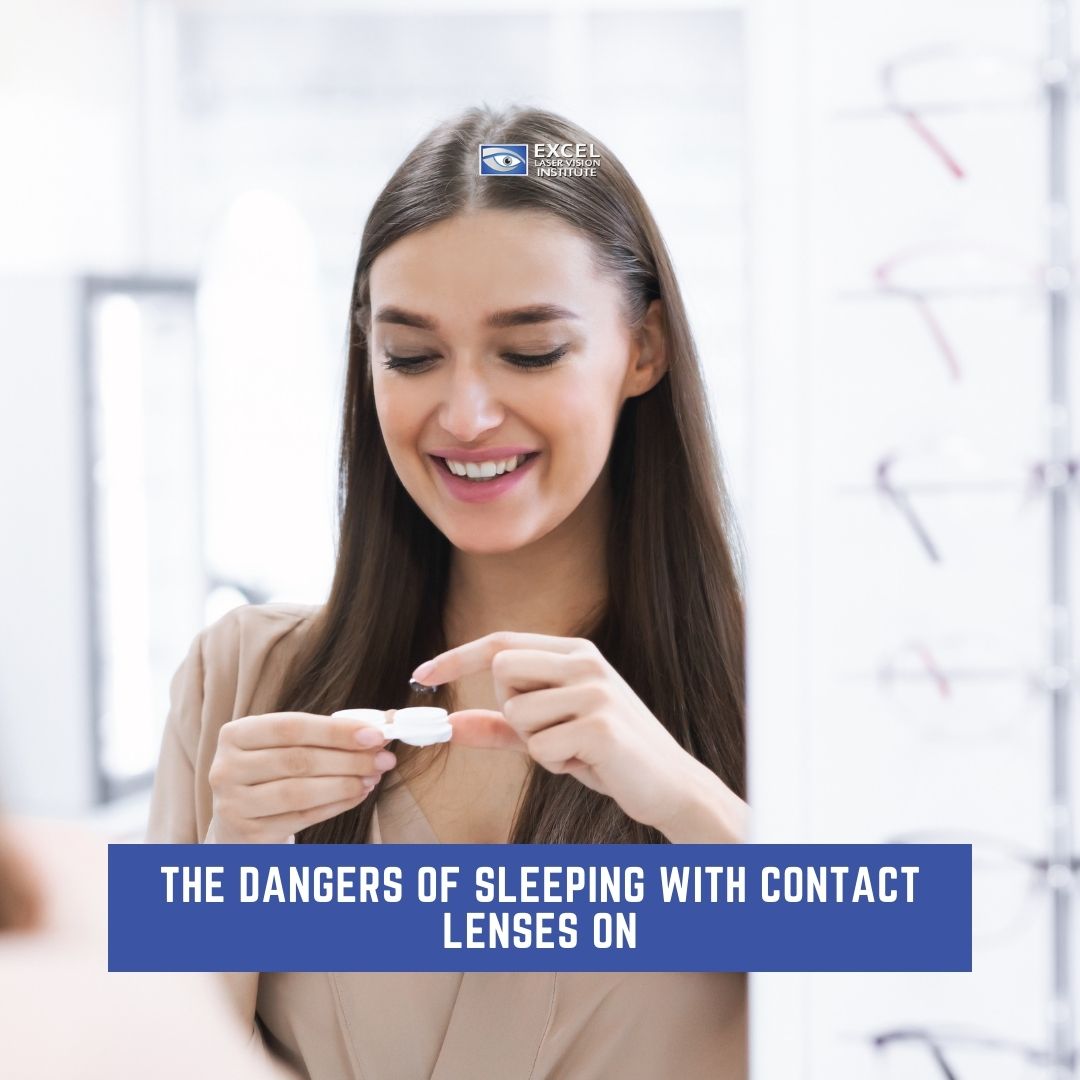
The Dangers Of Sleeping With Contact Lenses On
We have all been there, but some more than others. You know that feeling of struggle you have after a long day to do even the simplest and basic tasks such as washing your face or brushing your teeth. Suffice to say. It can be a tough assignment. And if you are someone who has to wear contacts, taking them out before you get forty winks isn’t your top ten things to do.
Nevertheless, just like skipping out on brushing your teeth can damage your oral health, laser eye surgery doctors, particularly Doctor Moosa in Los Angeles, warn us that wearing contacts while you sleep can impair and injure your eyes.
Physicians, professors, medical specialists, optometrists, and LASIK specialists like those at Excel Laser Vision Institute in Los Angeles agree that no one should sleep in contact lenses. Although this is practically common sense – you shouldn’t sleep with contact lenses in; it just mistakenly happens. For instance, you “mistakenly” ate a dozen donuts or “mistakenly” maxed out your credit card on your recent Amazon shopping spree.
If you think this is just mere talk from the LASIK medical professionals in LASIK Los Angeles, think again. Some people go blind as a result of catching a few zzzz’s with their contact lenses. Therefore, if you or a loved one wears contact lenses, it would be a good idea to discover the possible risks. Keep on reading to get some more helpful information about this risky habit.
Contacts Prevent Oxygen From Going To Your Eyes
The LASIK eye center staff, specifically those at Excel Laser Vision Institute in Los Angeles, let us know that when our eyes are open, they get oxygen from the air, which, just like other bodily functions, is required to perform correctly. That means when you put in contacts, your eyes receive a little less oxygen. And when you close your eyes, the supply of oxygen decreases even further. This makes your eyes more susceptible to irritation and redness, which is responsible for impaired vision.
This deterioration of oxygen supply can also escalate your risk of getting bacterial or fungal infections, along with corneal ulcers.
How Bad Is It To Sleep In Contact Lenses?
If you want the truth from Doctor Moosa, a LASIK specialist in Los Angeles, it is incredibly hazardous to your eye health.
Without a doubt, the LASIK eye center surgeon will tell you that sleeping with your contacts is an awful idea.
Sometimes the only way to make people understand and give them a little motivation is with shock therapy. Here are some frightening problems that could happen if you fall asleep in your contacts:
You Could Get Pink Eye Sleeping In Contacts
A widespread eye problem to arise when you sleep with your contacts is conjunctivitis, better known as pink eye. Generally, this eye infection can also be caused by allergies or contact with someone else who is infected, but it is usually caused by wearing contacts overnight.
What is the reason for this? Sleeping in contacts can make your eyes more vulnerable to microscopic tears on the cornea and can triple your odds of bacteria, as well as fungi, getting in and staying in your eye for an extended period. If you want to prevent a severe case of pink eye, remove your contacts before you zonk out.
You Could Get An Eye Ulcer Sleeping In Contacts
If you sleep in contact lenses, you are at high risk of developing corneal ulcers. A recent study found that corneal ulcers are one of the leading causes of blindness around the globe. Fundamentally, a corneal ulcer is a tiny, open wound in your eye. As mentioned above, contact lenses are notorious for blocking your vision. Therefore, when your eyelids are shut during the night, your cornea is refused the necessary oxygen it needs. As a result, the perfect breathing ground of bacteria reigns over, causing a disruption in the epithelium, bringing about an ulcer.
Not getting treatment quickly can cause lifelong vision damage, so eye doctors strongly recommend that this condition should be treated immediately.
Severe Red Eye Could Happen If You Sleep In Your Contacts
If you nap in your contacts, you could be prone to an eye condition called CLARE, also known as Contact Lens Acute Red Eye. This eye condition brings symptoms such as light sensitivity, redness, tearing, and decreased vision. Some people also refer to it as Tight Lens Syndrome or Contact Lens Overwear Syndrome.
Although you probably can’t stand wearing glasses, which is most likely the reason you wear contacts, to begin with, you may want to change your frames at night, so you don’t forget to remove your contacts before hitting the hay.
Your Contacts Could Start To Fit Incorrectly
Wearing your contacts overnight or for long periods can lead to severe irritation causing bumps to form underneath your eyelids. Giant papillary conjunctivitis (GPC) makes the inside of your eyelid red, swollen, and irritated. Individuals who wear contact lenses when they are sleeping have a high risk of experiencing this awful condition.
The bumps that come out when you have giant papillary conjunctivitis (GPC) make them fit improperly and are challenging to clear up. If you notice this happening to you, avoid wearing contacts for at least a week and see if your symptoms have eased off.
How To Lower Your Exposure To Contact Lens-Related Eye Infections
To lower the dangers of developing any awful symptoms or an eye infection, here are some sound principles of behavior to obey if you are a contact lens wearer.
Don’t reuse disposable contacts.
Never go to sleep in your contact lenses.
Remove your contacts before swimming.
Change disposable contact lenses frequently.
Don’t touch or rub your eyes with unclean hands.
Always use clean, sanitized hands when putting in/taking out your contacts.
Never share your contacts with anyone else.
Do not purchase fashion contact lenses.
Sadly, contacts cause headaches, so do your best to follow the guidelines above when wearing lenses. If you ever experience redness, light sensitivity, pain, decreased vision, or swelling while wearing your contacts, delicately remove them and contact your eye doctor.

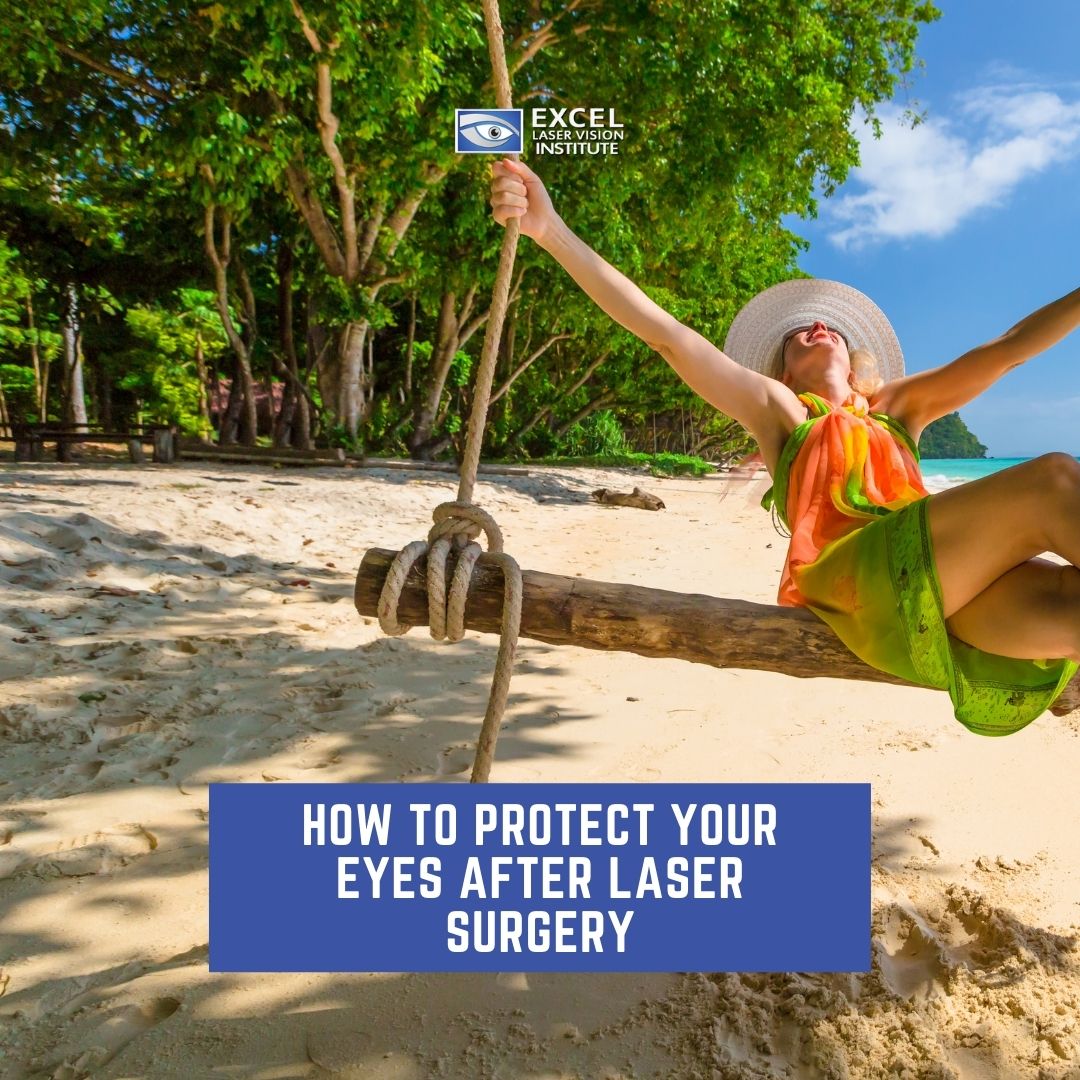
How To Protect Your Eyes After Laser Surgery
If you have decided to go through LASIK eye surgery, you have made the right choice to improve your overall vision. However, LASIK eye specialists in Orange County want to clarify that you still have to protect your eyes even after you have had the procedure.
Therefore, after you have had the best laser eye surgery, make sure you get the best post-operative results and safeguard your vision with these important steps to protect and promote your overall eye health.
After your LASIK eye surgery procedure, your ophthalmologist will give you post-operative instructions to follow to assist in a smooth recovery. Nevertheless, when you have completely recovered, you should still practice specific things to make sure you protect your eyes.
Below are some of the best practices to protect your eyes after having LASIK eye surgery. This will allow you to get the best results after your procedure and also help you to protect your eyes from future diseases and injuries.
Best Practices After LASIK Eye Surgery
Carefully Plan Out Your Activities
One of the biggest benefits of LASIK eye surgery is the fact that it provides a fast recovery time, and most patients return to their normal routines within 24 hours. Still, you won’t be able to participate in every activity immediately. For instance, you won’t be able to do certain strenuous activities for at least a few days or a week in some situations. This is why your eye surgery and you should have a recommended activity schedule to follow accordingly.
For example, it is important to refrain from any activities that could lead to your eyes being poked, rubbed, or touched on surgery day. You will have to forget showering since you don’t want to get water and soap in your eyes. Also, you won’t be able to drive, and your doctor will make it clear to avoid alcohol.
Nonetheless, three days after your surgery, you should be able to carry out light exercise or outdoor activities. Also, if you feel like taking a dip, you can wear goggles while you swim, wear eye makeup, and suntan. One week after the procedure, you can move forward with more vigorous activities, such as sailing or swimming, without the need for goggles.
You must remember that even when you are completely recovered and can participate in many activities, you must use the appropriate protective gear, such as safety goggles. This is very important if you have a job in which eye injuries are highly likely in the workplace.
Go To Post-Operative Exams And Appointments
After your procedure, Excel Eye Vision will schedule several mandatory post-operative exams for you to monitor your progress during your recovery. These usually take place at the following times:
- 24 hours post-procedure
- 2 weeks post-procedure
- 1-year post-procedure
It is also crucial that you regularly attend your eye exams. This is only to check the results of your LASIK eye surgery and also to keep track of your overall eye health. This is essential even if you aren’t experiencing any obvious problems with your vision since many eye issues stay under the radar, such as glaucoma, cataracts, diabetic retinopathy, and macular degeneration.
For adults who are younger than 40 who don’t have any known eye issues or symptoms, it is usually recommended to have a routine eye check-up every two years. Nevertheless, since eye health usually deteriorates with age, individuals who are 40 years old and older should get their eyes checked every 1 to 2 years. Those who have a history of eye problems should think about seeing their eye doctor at least once a year.
Treat Dry Eyes
Some patients experience dry eyes after laser eye surgery, even though this side effect is only temporary in many situations while the eyes heal. Dry eyes are distinguished by the following symptoms:
- Burning, red, or itchy eyes
- Excessive tearing
- The sensation of sand in the eyes
There are several ways to treat dry eyes. For instance, the most usual methods to treat dry eyes consist of over-the-counter drugs or prescription medications. Additionally, you can find pain relief from the symptoms by putting a warm, wet cloth over the eyes for five minutes, massaging the eyelids with a mild soap (i.e., baby shampoo), or trying Omega-3 supplements and castor oil drops.
Additionally, you try a comfort plug, which is a microscopic plug inserted into a patient’s tear duct. It helps to boost the level of the tear film, which then helps to regulate moisture levels and reduce the discomfort you have when experiencing dry eyes.
When Outdoors, Wear Sunglasses
This goes for everyone and not just those who have had LASIK eye surgery. Wearing sunglasses is important to make sure your overall eye health is good. Especially, sunglasses are important for protecting the eyes from the sun’s UV rays, which can cause cataracts and macular degeneration, among many things.
Be careful since not all sunglasses are made the same. Wearing sunglasses that don’t have enough protection will not do much to protect your eyes. As a matter of fact, the American Academy of Ophthalmology (AAO) recommends looking for sunglasses that have a tag or sticker pointing out they block 99% to 100% of UV rays.
What’s more is that your eye surgeon will instruct you to wear a special pair of sunglasses right after your LASIK eye surgery, which the clinic will provide you with. You should wear these sunglasses rather than your personal pair, which may not give enough protection. Afterward, keep wearing quality sunglasses that block 99% to 100% of UV rays when outdoors.
Protect Your Eyes From Digital Eye Strain
Digital eye strain (also referred to as computer vision syndrome) refers to a myriad of vision-related problems caused by long exposure to digital devices. It’s identified by symptoms such as:
- Eyestrain
- Headaches
- Blurred vision
- Dry eyes
- Neck and shoulder pain
Digital eye strain has been linked to many short and long-term health problems. Whether you work at a computer or just scroll through a phone or tablet in your personal time, taking steps to protect your vision from the blue light emitted by digital screens is crucial to ensuring overall eye health.
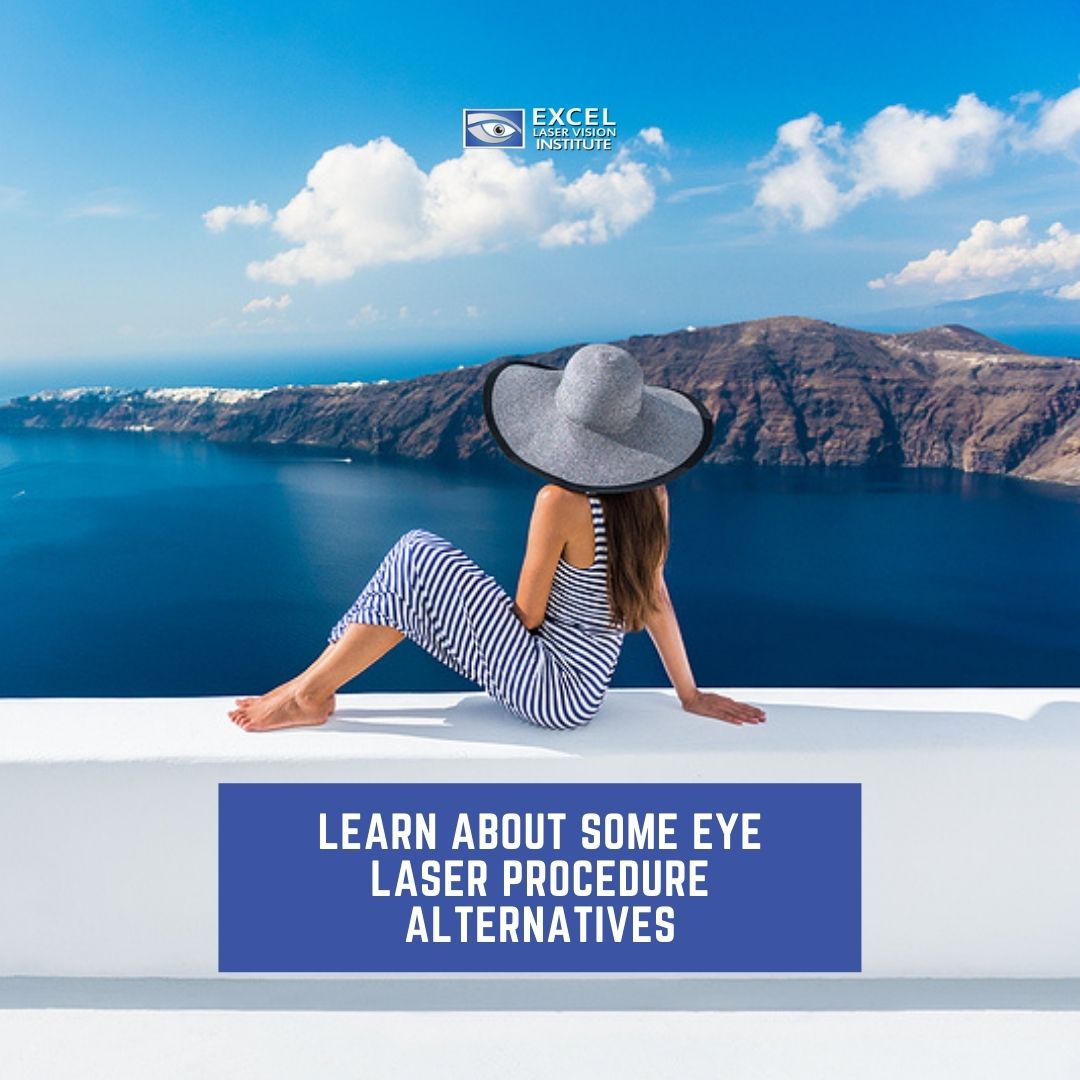
Learn About Some Eye Laser Procedure Alternatives
Doctor Moosa, an ophthalmologist and a LASIK surgeon in Los Angeles, will go out of his way to make certain he provides you with the best vision correction option. Without a doubt, LASIK eye surgery is probably the most popular choice, and we have the best LASIK surgeons who can professionally provide this procedure to patients; however, it may not be the best way to go for everyone.
So, the experienced LASIK team in Los Angeles wants to let you know about some LASIK eye surgery alternatives. Many of our highly skilled LASIK surgeons have hands-on experience with a vast range of vision correction procedures.
LASIK Alternatives
At the LASIK clinic of Excel Laser Vision Institute in Los Angeles, we provide many refractive options for vision correction. Depending on your individual requirements and goals, one of these vision correction procedures could be most suitable for you:
Visian ICL
Visian ICL is an Implantable Collamer® Lens that provides many advantages, especially for patients who cannot have LASIK surgery because they suffer from a high level of myopia (nearsightedness), thin corneas, or dry eye. Visian ICL does not cause Dry Eye Syndrome, which can be a worry when undergoing LASIK. Visian ICL also offers UV protection and has an excellent patient satisfaction rate.
Visian ICL is implanted behind the iris, in front of your eye’s natural lens during a 20–30-minute procedure. The patient can expect quick vision improvement with minimal recovery time, and the individual will not be able to see or feel it when it is inserted. Contrary to LASIK, which permanently alters the shape of the cornea, Visian ICL is an additive technology that can be removed if there is a need to do so. The best candidates for Visian ICL are aged 21 to 45 with moderate to severe nearsightedness (prescription between –3D and –20D) and a prescription that has been stable for at least one year. Also, Visian ICL can treat astigmatism (1.0D and 4.0D).
LASEK
LASEK, or(laser-assisted subepithelial keratomileusis) surgery, is different from its LASIK sibling. LASIK focuses on corneal sculpting, whereas LASEK concentrates on the cornea’s very top layer or epithelium. An instrument is used to create a flap of corneal tissue; then, the eye surgeon applies an alcohol solution to loosen epithelial cells. After that, the cornea itself is sculpted. Healing normally takes around four days.
PRK
Photo-Refractive Keratectomy (PRK) is a laser vision correction surgery that involves removing the outer layer of the eye’s surface to avoid an incision in the cornea. Like LASIK, a laser is then used to vaporize the cornea to correct refractive errors. Visual improvement and recovery time may take slightly longer than LASIK eye surgery or Visian ICL lens implantation procedures, but it is still an excellent option for many people.
PRK may be an option for patients who cannot have LASIK surgery because they have thin corneas but can only correct nearsightedness with a prescription up to -8 D. The most suitable candidates for PRK are over 18 and have had a stable prescription for at least one year.
CLE
Clear Lens Exchange (CLE) is a vision correction surgery that involves an experienced eye surgeon replacing the eye’s natural lens with an artificial intraocular lens (IOL), just like cataract surgery. CLE can correct a vast amount of vision errors depending on the type of IOL that is selected.
If this procedure sounds familiar to you, it is because it is very similar to cataract surgery and is usually performed on one eye at a time.
Wavefront-guided LASIK
During a traditional LASIK procedure, the laser is programmed to carve the cornea based on the patient’s vision correction prescription, focusing on 20/20 vision. Unlike wavefront-guided LASIK, which has the laser programmed with the patient’s wavefront data, which creates a three-dimensional model of the existing cornea, the laser can sculpt it more precisely for vision correction.
This three-dimensional map looks very similar to a mountain range, allowing technology to correct smaller abnormalities on the surface, getting better correction than just a prescription number for glasses or contact lenses. Also, this procedure lowers the risk of side effects such as problems with night vision or light sensitivity.
EpiLASIK
Just like LASEK, this procedure concentrates on the epithelial tissue of the cornea. A special microkeratome, called the epi-keratome, separates a thin sheet of epithelial tissue from the cornea and is lifted to one side. After it is treated, it may be replaced or removed, depending on the requirements of the reshaped cornea to create perfect vision.
Conductive keratoplasty (CK)
It is a non-invasive procedure that precisely treats mild to moderate farsightedness in patients over the age of 40, usually when presbyopia develops. This utilizes thermal refractions created to radiofrequency (RF) energy rather than a laser, applying heat to the cornea to change it. Instead of removing layers of cells, the RF emissions make the peripheral areas of the cornea contract, tightening it like you would a belt, which increases the curvature of the cornea itself. Also, CK is used to create monovision, or blended vision, which improves a person’s ability to focus on all depths. One eye’s near vision is enhanced while the other eye is set to far vision. For the majority of people, farsightedness will return as the eyes continue to age.
How To Choose The Right Vision Correction Surgery
There are many elements and influences to think about when deciding on a vision correction procedure. Your eye doctor is the best person to make a suitable choice for you based on your prescription, lifestyle, and the advantages you are looking for. At Excel Laser Vision Institute in Orange County, our advanced eye care team has the experience that is vital when trying to find the right procedure for you. Call Excel Laser Vision Institute at (888) 957-3255 or visit our website to learn more about LASIK alternatives or to schedule an appointment.
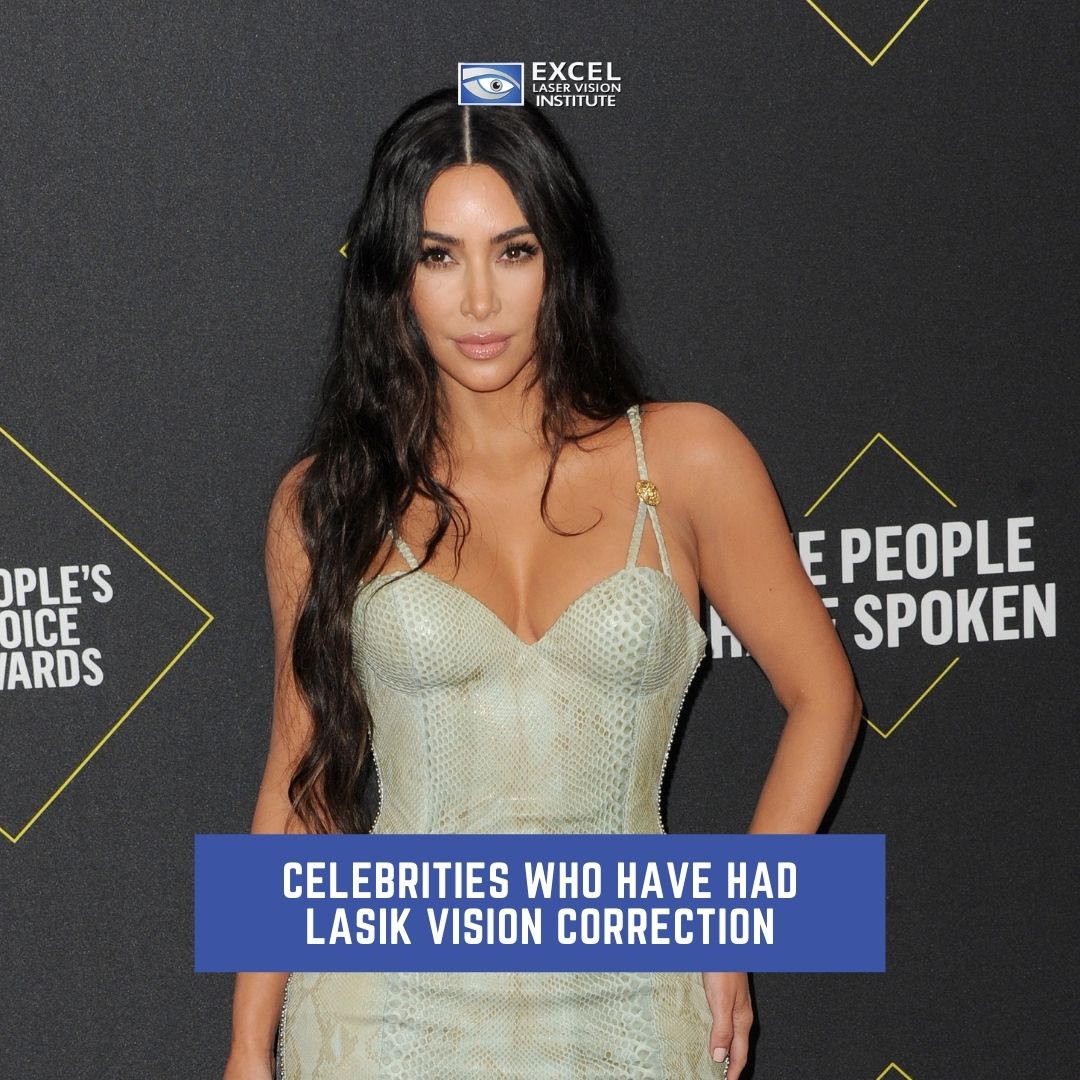
Celebrities Who Have Had LASIK Vision Correction
Nowadays, it isn’t common for someone you know to have gone through a LASIK procedure. So, many people have done this laser eye surgery in Orange County, and that includes many of your favorite celebrities. Stick around to find out who has had LASIK eye surgery.
What Is LASIK Surgery?
LASIK, also known as (laser-assisted in situ keratomileusis) surgery, is a vision correction procedure that allows a person to see clearly without eyeglasses or contacts. During this LASIK procedure, tiny precision lasers alter the shape of your cornea so that the patient’s retinas focus properly. So, you can eliminate refractive eye errors such as myopia, astigmatism, or hyperopia! The whole process by a LASIK surgeon only takes 15 minutes for both eyes, and one to three days later, the patient has perfect vision.
Some people decide to go for Lasik treatment as the best way to correct serious vision issues, while others just want to live their lives without having to bother with eyeglasses.No matter what the reason is, 98 percent of patients love their results and claim that making the decision to have LASIK was one of the best decisions they have ever made.
LASIK surgery is very safe, effective, and, most importantly, it is painless. Also, it is the most common elective surgery in the world. You probably don’t know anyone who has gone to Excel Laser Vision Institute, a LASIK clinic in Orange County, to have this procedure, but you have most likely heard of many LASIK success stories.
Find out about the ten most famous celebrities who have had LASIK and don’t regret a thing.
Bonnie Tyler
If the 1990’s top 40 was your thing at one time, you may remember Bonnie Tyler for super hits such as “Holding Out for A Hero” and “Total Eclipse of the Heart.” Whether you do or not, it is good to note that she once struggled with astigmatism, farsightedness, and presbyopia. She is still in awe at how clear her vision became as soon as she did her LASIK surgery. She even goes on to say that she wishes she had done it sooner.
Courtney Cox
Courtney Cox once had such poor vision that it almost made her acting career go off the rails. She had 20/400 vision that made it almost impossible to read scripts, read cue cards, and even recognize her Friends co-stars.
Eventually, she decided to ditch her eyeglasses and contacts and correct her vision permanently with LASIK.
Cindy Crawford
During her international supermodel days, Cindy Crawford had to wear contacts. She finally decided to get LASIK when she got fed up with managing her lenses under layers of eye makeup. Needless to say, the procedure changed her life for the better. So much so that if you ask her today about having LASIK surgery, she will highly recommend the procedure to anyone without any uncertainty.
Lisa Ling
Lisa Ling says that she wouldn’t have gone as far as she did with her journalism career without LASIK surgery. She claims: “As someone who is constantly on the road for her job and sometimes unable to find the most sanitary of conditions, liberating myself from contact lenses and glasses has made my life infinitely easier. It’s been more than a decade since the surgery, and I can see just as clearly as ever.”
Elton John
World-famous singer and pianist Elton John made his over 250,000 pairs of bedazzled, feathered, and multi-colored glasses part of his act. However, getting each pair decked out with a prescription cost him a fortune, so he decided to get LASIK instead. Nowadays, he can freely change his glasses without spending tons of cash.
Drew Carey
Drew Carey had LASIK surgery way back in 1999, but you may notice that he still wears glasses. Funny thing, right? Well, the story goes that he tried not wearing them for a while, but he soon realized that people didn’t recognize him. Now he just wears his black-framed eyeglasses for aesthetics and his own way of giving himself brand recognition. And that goes with anyone – if you like the way you look in glasses, but you still want to correct your vision and not have to rely on eyewear to see clearly, you can do so with LASIK.
Kim Kardashian
Since LASIK surgery is so fast and convenient, many people decide to get it done before special occasions such as weddings and graduations. As a matter of fact, Kim Kardashian had the procedure in 2009 before she got married to her first husband, Kris Humphries. Although her marriage didn’t work out, she still loves the fact she doesn’t have to wear eyeglasses that hide her beautiful face.
Nicole Kidman
Nicole Kidman was almost declared legally blind before she had LASIK. Before that, she struggled with blurry vision her entire life but decided to have the procedure after being nominated for an Oscar. She mainly did the procedure because she wanted to read her acceptance speech without glasses or contacts. Now she is way happier with her 20/20 vision.
Dennis Quaid
Before Dennis Quaid decided that a LASIK procedure was the best option for him, he was well-known for losing his reading glasses. He used to leave his house with five pairs and return home without a single one! So, Quaid did LASIK surgery so he would stop spending silly amounts of money buying numerous pairs of glasses to read scripts with clearer vision.
LeBron James
Many athletes opt for LASIK since eyewear can get in the way when they are on the court or field. One famous athlete, basketballer LeBron James did the procedure in 2007 and let reporters know that he can see the rim and net a lot better now. Indeed, his field goal percentage jumped three points to an extraordinary 49 percent. Without having to wear contacts, he doesn’t have to worry about sweat irritating his lenses or a lens popping out while he is running up and down the court.
If you have seen one of your favorite celebrities on the list above and want to learn more about LASIK, contact Excel Laser Vision Institute at (888) 957-3255 or visit our website.
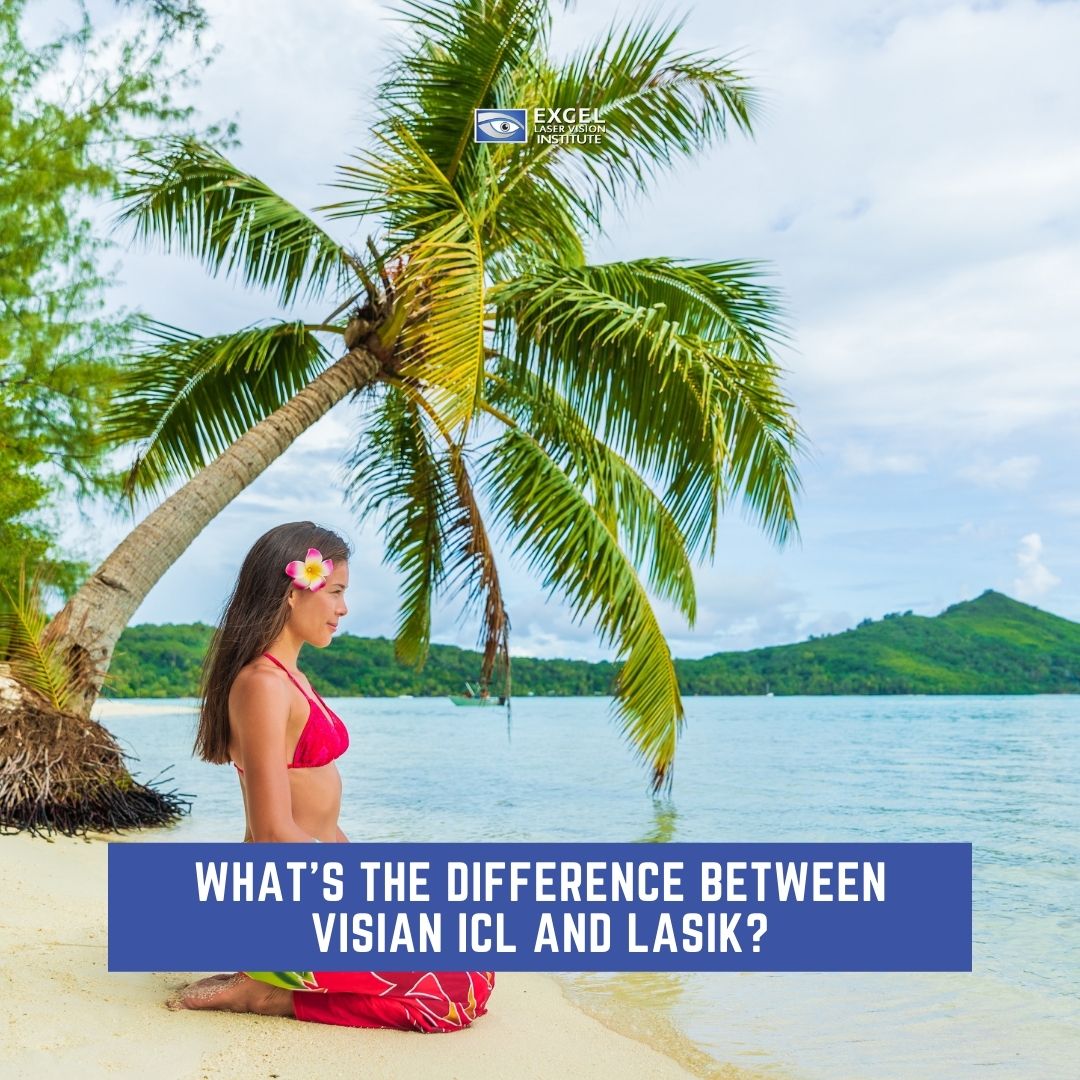
What’s The Difference Between VISIAN ICL and LASIK?
Patients often get confused about the differences between Visian ICL and LASIK. Doctor Moosa, a LASIK surgeon in Orange County, is quick to tell us that it boils down to individual factors. Some patients are usually best suited for one procedure over the other, depending on their own personal requirements. Nonetheless, there are various differences between these two procedures.
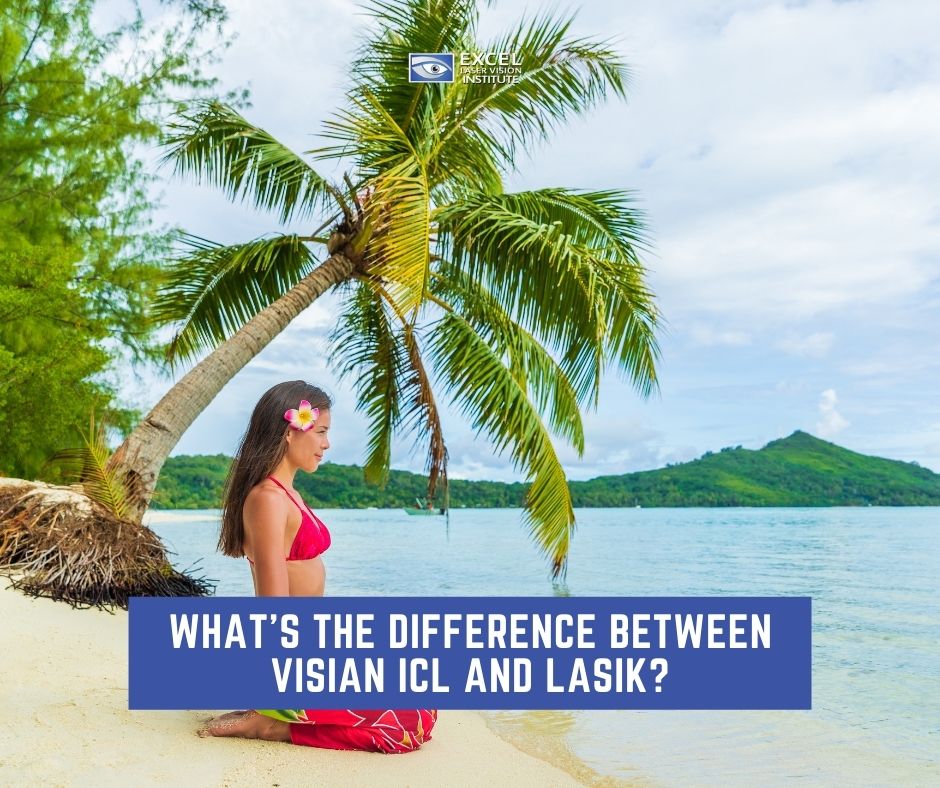
LASIK is a laser eye surgery procedure that is able to correct myopia, hyperopia, or astigmatism by reshaping the cornea using an excimer laser. On the other hand, Visian ICL is only suitable for myopia. It is very similar to having permanent contact lenses, so the cornea’s shape is not altered.
To be fair, Doctor Moosa, a LASIK surgeon in Orange County, stresses the fact that many types of refractive errors can be corrected with LASIK. However, individuals who have thin corneas or chronic dry eye may select Visian ICLs instead to avoid possible side effects.
Some patients will be happy to learn that LASIK is a shorter procedure, less costly, and has a faster recovery time compared to Visian ICL. The lenses used with Visian ICL may offer a reduced risk of side effects, better long-term correction, and they can be removed if the patient wishes to do so.
The procedure you choose is fundamentally up to you and your eye doctor. LASIK Eye professionals in Orange County can recommend the best option for you and your specific situation.
The Many Differences Between Visian ICL vs. LASIK
For several years, people who suffered from refractive errors had only two options for managing their condition: glasses or contact lenses. These options need regular eye exams to monitor the advancement of nearsightedness, farsightedness, or astigmatism. Afterward, regular updates to the lens prescription are required to continue correcting changes in the cornea.
Medical researchers have been working on new and improved methods since the 1990s to manage refractive errors. These include implantable lenses and laser-based surgery. These new treatment methods provide patients more options than ever before and can, in the course of time, free them from having to wear contact lenses or eyeglasses on a daily basis.
Laser-assisted in situ keratomileusis (LASIK) is one of the most well-known developments since contact lenses for correcting refractive errors. A laser removes tissue from your cornea to reshape it, which causes light to refract more clearly to the back of your eye. There, the retina receives the light and transmits it to your brain through your optic nerve.
LASIK has allowed millions of people all over the world to stop wearing glasses or contact lenses. It provides an easy, fast solution that can be positively life-changing.
On the flip side, they could be a reason that an eye surgeon does not recommend someone as a good candidate for LASIK. Hence the fact, that this has made scientists research other options. Implantable contact lenses, such as the Visian ICL series, let people who have thinner corneas or other eye conditions stop wearing glasses or contact lenses for years without undergoing laser-guided surgery.
Visian ICL vs. LASIK
LASIK and Visian implantable Collamer lenses (ICLs) are very different technologies that can correct your refractive error to 20/40 visual clarity or better in specific circumstances. Before you make your decision on which is more suitable for your requirements, it is best to have a good understanding of both procedures.
LASIK
Even though there are various types of laser eye surgery to correct refractive errors, LASIK is the most recognized type of this procedure and what most eye surgeons perform. This outpatient operation can correct myopia (nearsightedness), hyperopia (farsightedness not due to aging), and astigmatism, so you can often see 20/40 or better.
The process doesn’t take long at all, usually 15 minutes per eye, with much of that time involving prep for the operation. The patient receives numbing eye drops and a device to hold your eyelids open. Then, either a microkeratome (a special, small surgical knife) or a laser will cut a flap from the top of the patient’s cornea.
Then, an excimer laser removes tissue from strategic locations on the inside of the cornea to alter its shape. The surgeon puts the flap back in place and sends the patient home to relax for the rest of the day.
Many people experience good vision the next day, although having dry eyes is expected. Also, it is possible to experience halos or glares around lights and some blurry vision for a few days. Most people experience a slight decrease in these symptoms over six months while their eyes heal.
Visian ICL
Despite the fact that some surgery is involved with Visian implantable Collamer lenses (ICLs), no lasers will remove tissue from the patient’s cornea to reshape that part of your eye. Instead, Visian ICLs are a brand of phakic intraocular lenses (IOLs) similar to permanent contact lenses. Visian ICLs are manufactured by Staar Surgical, and they are designed to be implanted behind the iris but in front of your natural lens. They were approved for use in adults by the United States Food and Drug Administration (FDA) in 2005 to treat nearsightedness.
On the contrary to LASIK, Visian ICLs and other types of phakic IOLs do not treat other refractive errors such as farsightedness. If you have astigmatism and myopia, you may experience some improvement in your astigmatism, but they are not meant to treat just astigmatism.
Similar to LASIK, the implantation process for these flexible Collamer lenses takes around 15 minutes per eye, using a very small incision from a laser or a microkeratome. Recovery time after this outpatient procedure is slightly longer than LASIK, with vision returning to almost full clarity after seven days. Even though healing takes more time, there are fewer side effects reported with Visian ICLs.
If you want to learn more about how LASIK or Visian implantable Collamer lenses can help your eyesight, contact Excel Laser Vision Institute at (888) 957-3255 or visit our website. Our expert team and highly reputable LASIK surgeon, Dr. Moosa, are happy and willing to answer all your questions.

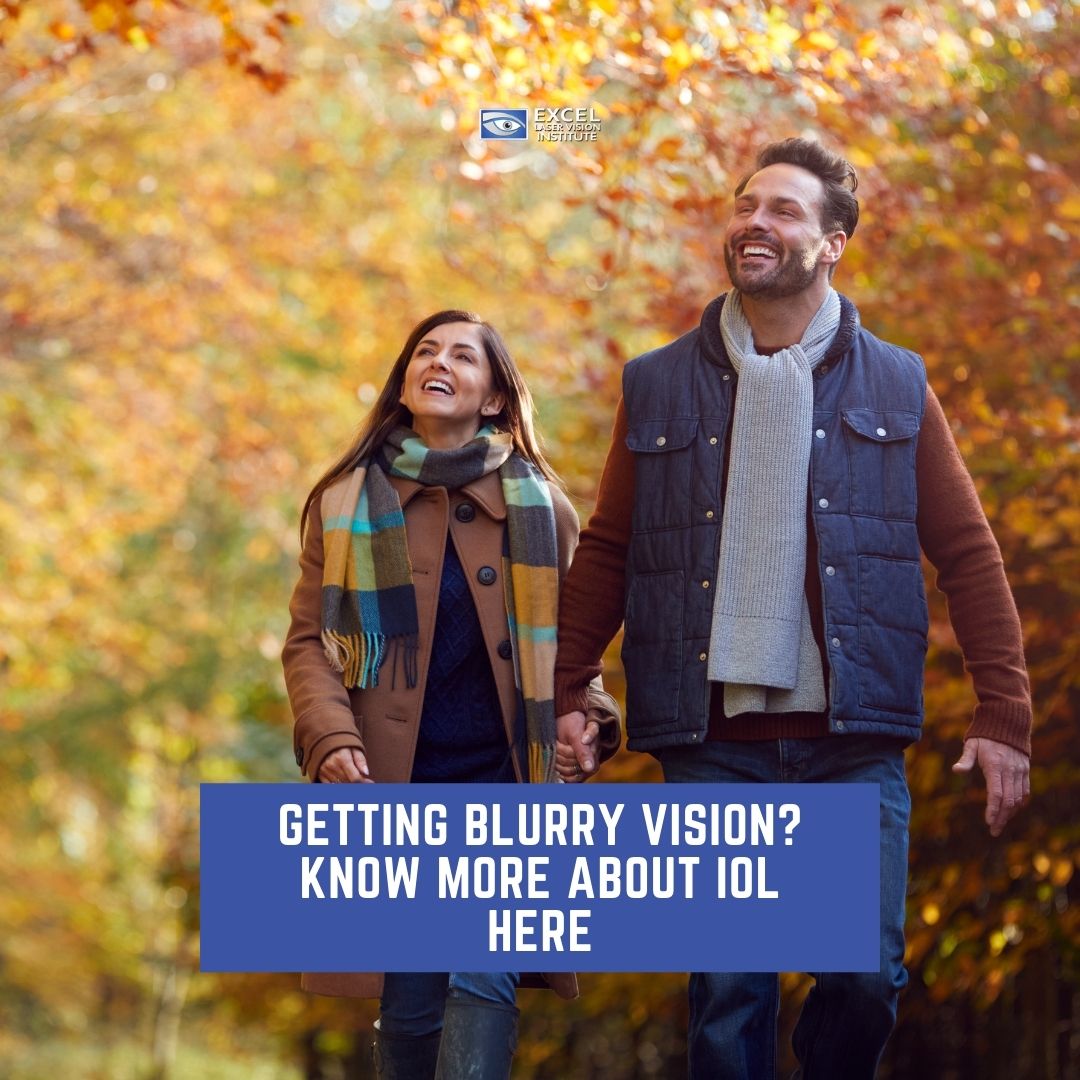
Getting Blurry Vision? Know More About IOL Here
If you are age 60 and above and have noticed a decline in your vision, it could be time to get in touch with a surgeon at Excel Laser Vision Institute, a cataract and LASIK clinic in Los Angeles. Doctor Moosa, our LASIK eye surgery doctor, says that it is very normal for people at this age to experience blurry or even cloudy vision, which may be a tell-tale sign that they have cataracts. It is a typical condition in older adults and can be treated by your eye doctor in Los Angeles through laser vision correction.
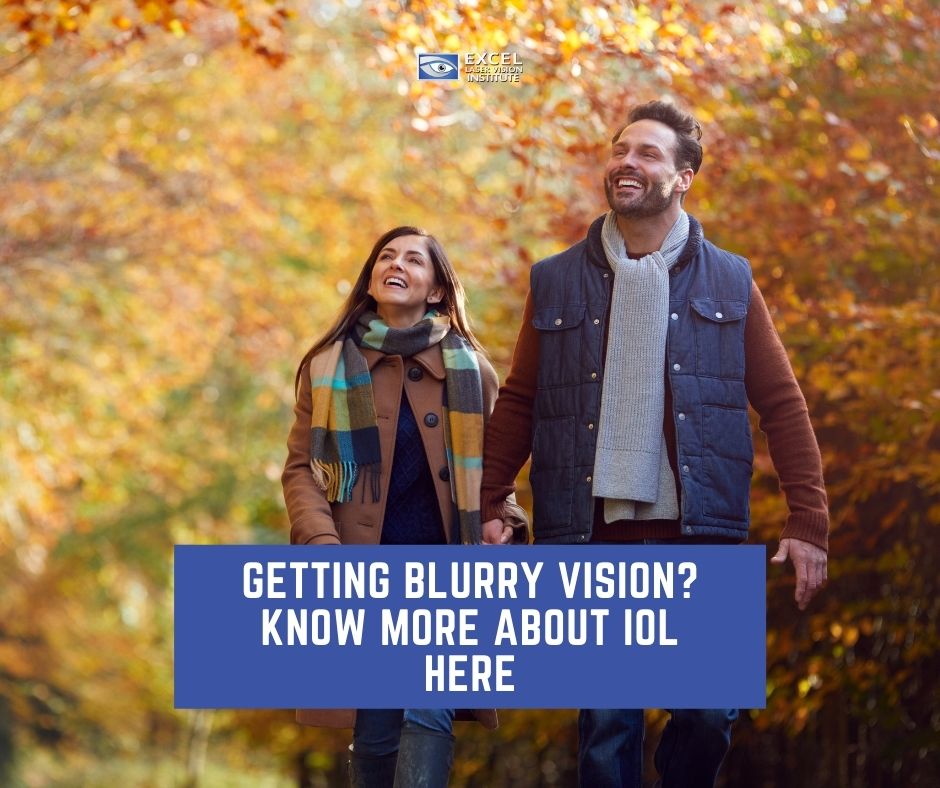
What Are The Symptoms Of Cataracts?
Cataracts usually start off slowly. As a matter of fact, eye specialists at a cataract and LASIK clinic in Los Angeles say that you may not know you have them until they begin to block light. After that, you may notice the following:
- Vision that is cloudy, blurry, foggy, or filmy
- Nearsightedness (in older people)
- Changes in the way you see color
- Complications driving at night (glare from oncoming headlights, for example)
- Problems with glare during the day
- Double vision in the affected eye
- Issues with eyeglasses or contact lenses not working well
What Causes Cataracts?
Cataracts happen when protein accumulates in the lens of your eye and makes it cloudy. This prevents light from passing through clearly. As a result of this, a person may experience loss of eyesight. Also, there are many types of cataracts.
How Your Eye Functions
Your eye has a lens, which is a window made of clear protein and water that sits behind the pupil. The lens focuses light onto the retina, which transmits it to your brain.
As a person starts to get older, the proteins alter, and parts of your lens turn cloudy. This is referred to as a cataract. It can make objects appear blurry or give them a brownish tint.
Cataracts are the main cause of blindness, particularly in the elderly. However, they can be corrected through cataract surgery that is performed over 2 million times a year in the United States.
What Is An Intraocular Lens Implant?
If you are considering corrective eye surgery at a cataract and LASIK center in Los Angeles, it may be a good idea to understand what an intraocular lens implant is. Essentially, an intraocular lens implant (IOL) is an artificial replacement for the lens of your eye. It forms part of the surgery to treat cataracts. An intraocular lens implant, or IOL, consists of clear plastic material, and it is around a third the size of a dime. There are various different types:
Monofocal IOL
This is the most common intraocular lens implant. It is very different from your natural lens, which can stretch or bend to help your eye focus since this implant stays focused at one fixed distance. If yours focuses at a distance, you might be able to see things far away but need glasses to read or see close up.
Multifocal implant
This implant is similar to glasses with bifocal or progressive lenses because this lens has areas that help you see things at different distances. It could take several months for your brain to get used to so your vision appears natural. Keep in mind that it can sometimes cause more halos or glare around lights than a monofocal lens.
Accommodating IOL
This is a more flexible option, especially if you are looking for a lens that mimics a lot like your natural lens and focuses at more than one distance. It can prevent you from requiring reading glasses.
Toric IOL: Your eye surgeon may recommend this if you have astigmatism or a cornea that’s more football-shaped than round. This can make vision blurry all over, not just close up or far away. This lens reduces astigmatism, so you won’t need glasses to correct it after your surgery.
How Is the Surgery Performed?
If you have a cataract, you should visit an ophthalmologist. This doctor specializes in cataract surgery and other issues requiring surgery. They will most likely let you know that it is recommended to remove the cataract until it begins to affect your daily life. They can perform the surgery at a hospital or an outpatient clinic.
To prepare you for surgery, your doctor will do the following:
- Measure your eye. This will help them select the right implant for you.
- Give you medicated eye drops to take for a few days ahead of time
- Ask you to stop taking some medicines or to avoid wearing contact lenses for several days beforehand
On the day of surgery, they will tell you to do the following:
- Numb your eye
- Administer a drug to help you relax. You may see light during the procedure, but you should feel nothing or only gentle pressure.
- Create a tiny cut through your cornea to get to the lens
- Break the lens up into pieces and remove it bit by bit
- Put the implant in place.
- Let the cut heal by itself. You will not have any stitches.
You can usually go home in less than an hour, but it is important that someone else drives you.
Follow-Up Care
It takes around 8 to 12 weeks to heal fully. During that time:
- Keep your eye protected with sunglasses as much as possible, and sleep with your eye shield at night.
- Don’t rub or press your eye, even if you have the urge to scratch it or you notice the eye begins to ooze a bit of fluid.
- Take the medicated eye drops your doctor prescribes. You may have to use them for several weeks to help your eye heal.
- Avoid most exercise or heavy lifting. The doctor will advise you when you can do those things again.
If you want to learn more about intraocular lens (IOL) implants, contact Excel Laser Vision Institute at (888) 957-3255 or visit our website. Our expert team and well-esteemed cataract and LASIK surgeon, Dr. Moosa, is ready to answer all your questions.

How To Delay The Progression Of Cataracts
Patients often ask whether there is a way of delaying cataracts since they may have a family member who has it. Laser eye surgery doctors in Los Angeles tell us that cataracts are the leading cause of blindness in the United States. Unfortunately, there is no guaranteed way to prevent them, but making some lifestyle changes could reduce your risk of getting them.

How Do Cataracts Happen?
The doctor at Excel Laser Vision Institute, a LASIK eye center in Los Angeles, points out that the real reason why medical professionals can’t find a way to delay cataracts is that it is more complicated than keeping a clear lens from becoming cloudy. So, the whole point isn’t about keeping the lens clear but more about how to stop it from aging. For now, scientists haven’t found a way to delay aging. However, they have a good idea of what causes it biochemically. And the same can be said for cataracts.
Every year, the lens in your eye lays down new layers, kind of like how a tree lays down new rings each year. Over time, the center of the lens gets more compressed, and it results in hardening and cloudiness. There is a type of biochemical bond referred to as a disulfide bond, and it occurs between the cysteine amino acids of the crystalline proteins in the eye. LASIK eye surgeons in Los Angeles confirm that there is no way to stop it or delay it.
How Do You Prevent Cataracts From Getting Worse?
Nevertheless, Doctor Moosa, a LASIK surgeon in Los Angeles, gives us five ways to prevent cataracts or keep them from getting worse. These methods are not difficult to incorporate into a healthy lifestyle, but they can possibly prevent you from becoming blind.
Stay Away From Lengthy Exposure To UV Light
Although a small amount of exposure to the sun is healthy, prolonged exposure to the sun’s ultraviolet rays can intensify cataract progression.
This doesn’t mean you have to lock yourself indoors most of the time. It is okay to go out as long as you protect yourself from the dangers of prolonged exposure to ultraviolet light.
When the sun is out, and you want to be outside, make it a point to wear sunglasses. As mentioned above, lowering the amount of ultraviolet light that reaches your eyes will help you prevent getting cataracts.
Also, don’t be fooled when there is a cloudy day since the sun’s rays can pass through thin clouds. The peak hours of the day for sun exposure are between 10 am, and 3 pm or else 11 am and 4 pm daylight savings time.
Don’t Use Steroid Drops
Sometimes ophthalmologists will prescribe steroid eye drops to treat dry eyes and arthritic flare-ups in the eyes. These steroids imitate the effects of cortisol in the body to lower inflammation.
Although steroid eye drops are useful when administered properly, they can have damaging side effects, which consist of the acceleration of cataracts.
If you do have to use steroid eye drops on a regular basis, you should have regular eye exams carried out. If you notice cataracts developing, speak to your optometrist or ophthalmologist as soon as possible.
Look Out For Medicinal Side Effects
Commonly prescribed medications have side effects that could trigger the cataract progress. If you are at risk for cataracts and take medication on a regular basis, ask your medical professional about any side effects you have to be aware of.
If you are taking necessary medication that could speed up cataracts, it is crucial that you avoid sunlight during peak hours, wear sunglasses or a hat during sunny days, and have regular eye exams.
Taking medication to enhance your life may not be worthwhile if it results in cataracts. So, think about your options carefully.
Think About Cataract Surgery
When cataracts have already set or progressed to a point where it disrupts many aspects of your life, you should think about having cataracts removed.
You can only remove it through cataract surgery, a process that involves removing your eye’s natural cloudy lens and replacing it with an artificial lens. One of the leading eye surgeons at Excel Eye Institute will discuss and advise you of the options for corrective lenses that are appropriate for you.
This is the best way to treat cataracts that have already set in, but it may not be the best solution for everyone. Make sure to contact your laser eye clinic to figure out if cataract surgery is the right option for you.
Live A Healthy Lifestyle
Research has shown that a healthy lifestyle can lead to reducing the development of cataracts.
And this is a very logical finding since a healthy lifestyle helps to fight against many ailments. But, what exactly comprises a “healthy lifestyle”?
Here are a few suggestions from existing studies:
Diet Guidelines
- People who have a diet that consists of colorful fruits, vegetables, and whole grains may show a reduced possibility of developing cataracts.
- Studies suggest that antioxidant vitamins in these fruits and vegetables may lower the risk of cataracts.
- Carrots are a great source of beta-carotene, which is converted into vitamin A in the body and is excellent for eye health.
- The consumption of fish has been linked to a reduced risk of cataracts.
- Fish are high in omega-3 fatty acids, which have been known to reduce cataract progression.
- A diet high in carbohydrates may speed up cataract progression.
- Foods that are rich in a variety of vitamins and minerals may delay cataracts.
Lifestyle Guidelines
- Dehydration can quicken the development of cataracts.
- Alcohol may accelerate the development of cataracts.
- Smoking will increase the chance of developing cataracts.
- Obesity may increase the chances of developing cataracts.
- Individuals with diabetes may be at a higher risk of developing cataracts.
Many people over the age of 50 will eventually develop age-related changes in their lenses, known as “early cataracts.” It may be challenging to prevent cataracts from progressing entirely, but you could live cataract-free by taking account of these guidelines.



